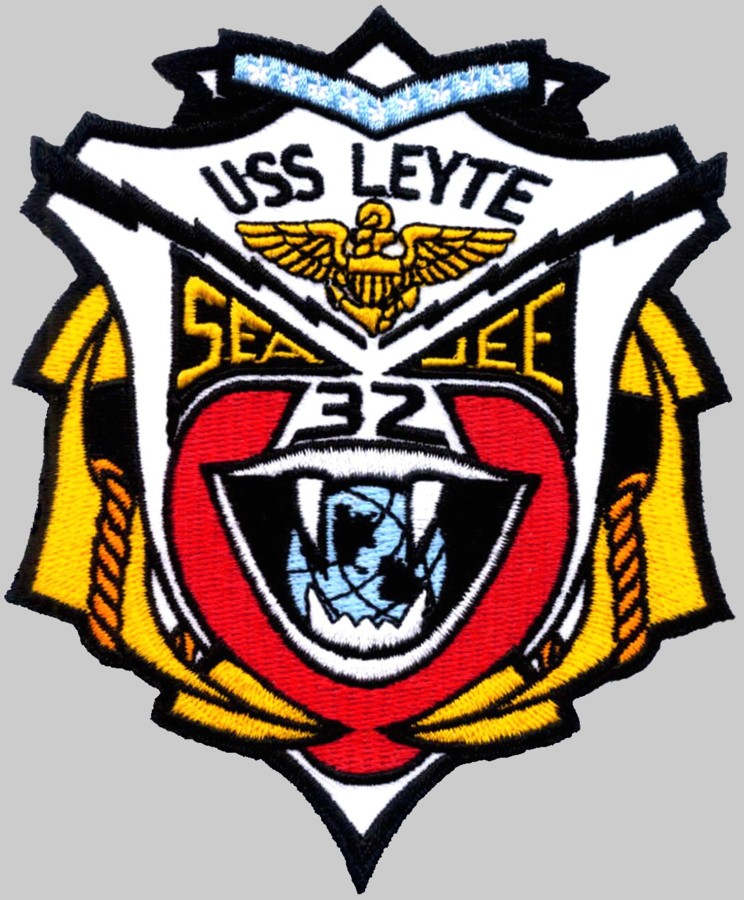 |
||
|
HOME
|
US Navy -
ships
|
US Navy - air
units
|
USMC - air
units
|
International
Navies
|
Weapon Systems
|
Special Reports |
||
|
US Navy - Aircraft Carrier CV 32 / CVA 32 / CVS 32, AVT 10 - USS Leyte |
||
|
||
| 01/20 | ||
|
Type, class: Aircraft Carrier, Essex class (long
hull) Builder: Newport News Shipbuilding, Newport News, Virginia, USA STATUS: Awarded: Laid down: Febrary 21, 1944 (as Crown Point) renamed Leyte on May 8, 1945 Launched: August 23, 1945 Commissioned: April 11, 1946 reclassified CVA 32 on October 1, 1952 reclassified CVS 32 on August 8, 1953 reclassified AVT 10 on May 15, 1959 Decommissioned: May 15, 1959 Atlantic Reserve Fleet 1959-69 Fate: sold for scrap in September 1970 / finally scrapped in Chesapeake, Virginia Namesake: Battle of Leyte Gulf (1944) Ships Motto: ? Technical Data: see: INFO > Essex class Aircraft Carrier - CV |
||
|
Deployments - Carrier Air Groups/Wings embarked: August 1946 - December 1946 with Carrier Air Group 18 (CVG-18) - Pacific Ocean via Panama Canal April 1947 - June 1947 with Attack Carrier Air Group 7 (CVAG-7) - Mediterranean Sea July 1947 - November 1947 with Attack Carrier Air Group 7 (CVAG-7) - Mediterranean Sea September 1949 - January 1950 with Marine Aircraft Group 11 (MAG-11) - Mediterranean Sea May 1950 - August 1950 with Carrier Air Group 3 (CVG-3) - Mediterranean Sea September 1950 - February 1951 with Carrier Air Group 3 (CVG-3) - Pacific Ocean, Korean War September 1951 - December 1951 with Carrier Air Group 3 (CVG-3) - Mediterranean Sea August 1952 - February 1953 with Carrier Air Group 3 (CVG-3) - Mediterranean Sea |
||
| images | ||
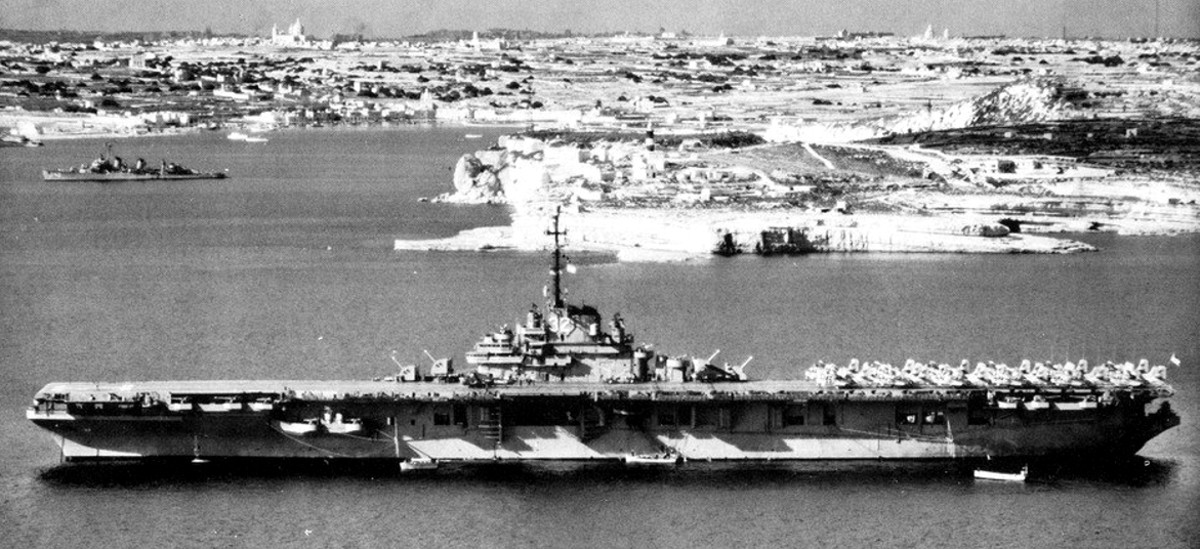 USS Leyte (CVS 32) at anchor off Malta - late 1957 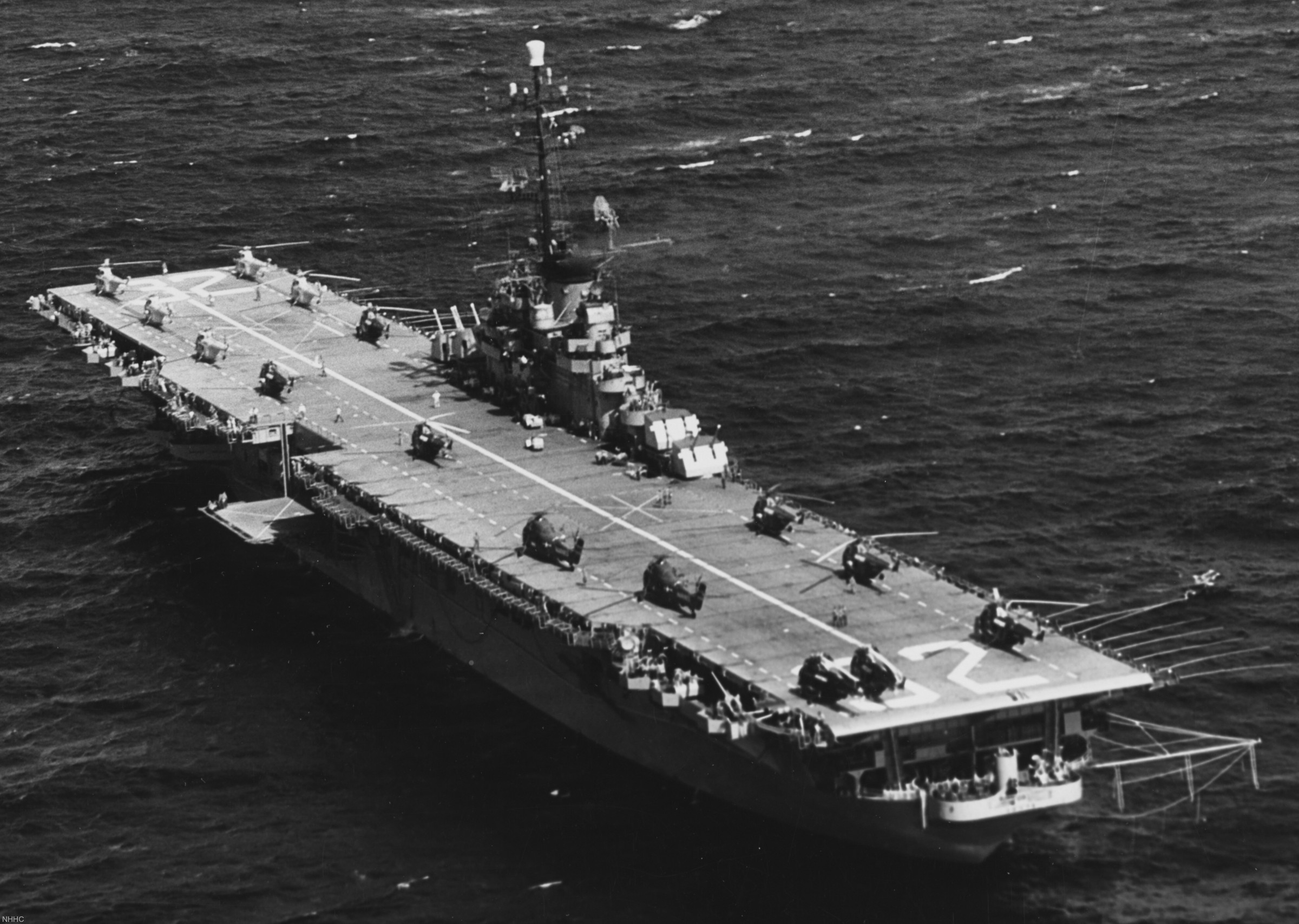 USS Leyte (CVS 32) off Puerto Rico - July 1957 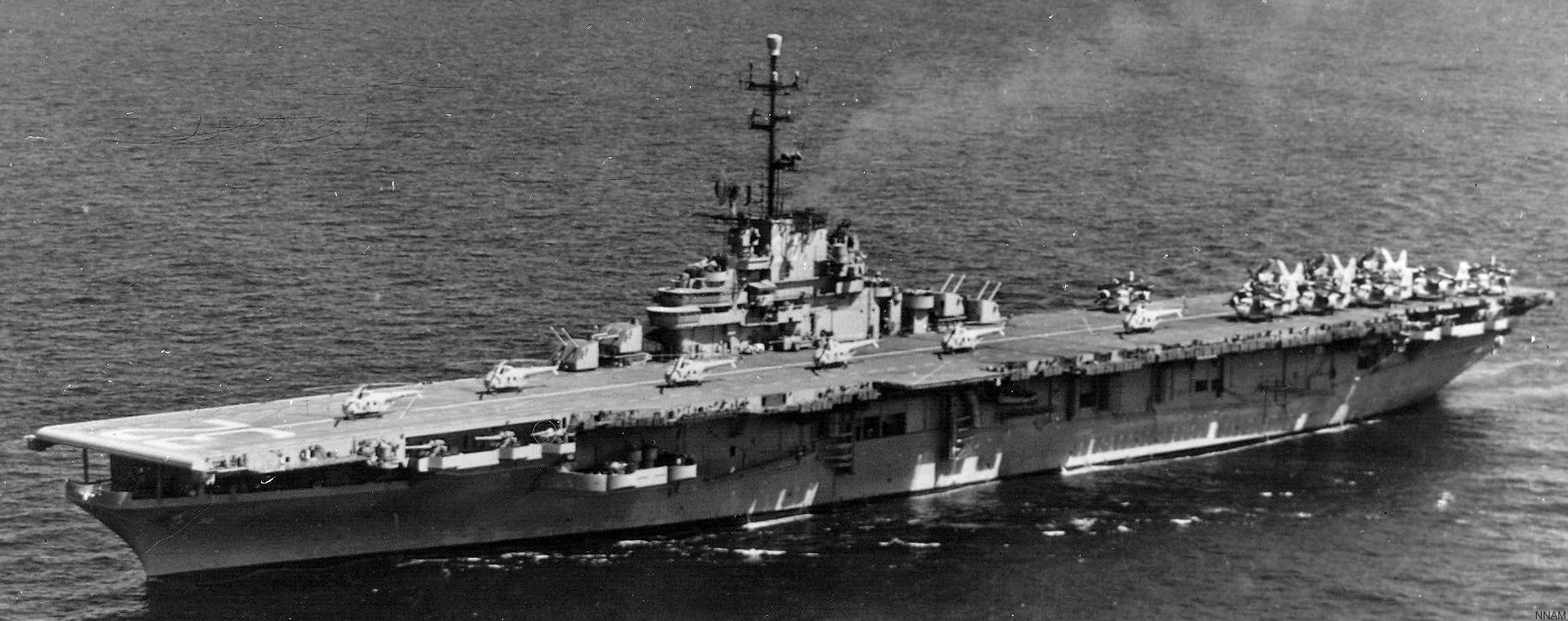 USS Leyte (CVS 32) - 1957 on deck are six Sikorsky HO4S helicopters, six Grumman S2F Tracker and three Douglas AD Skyraider aircraft 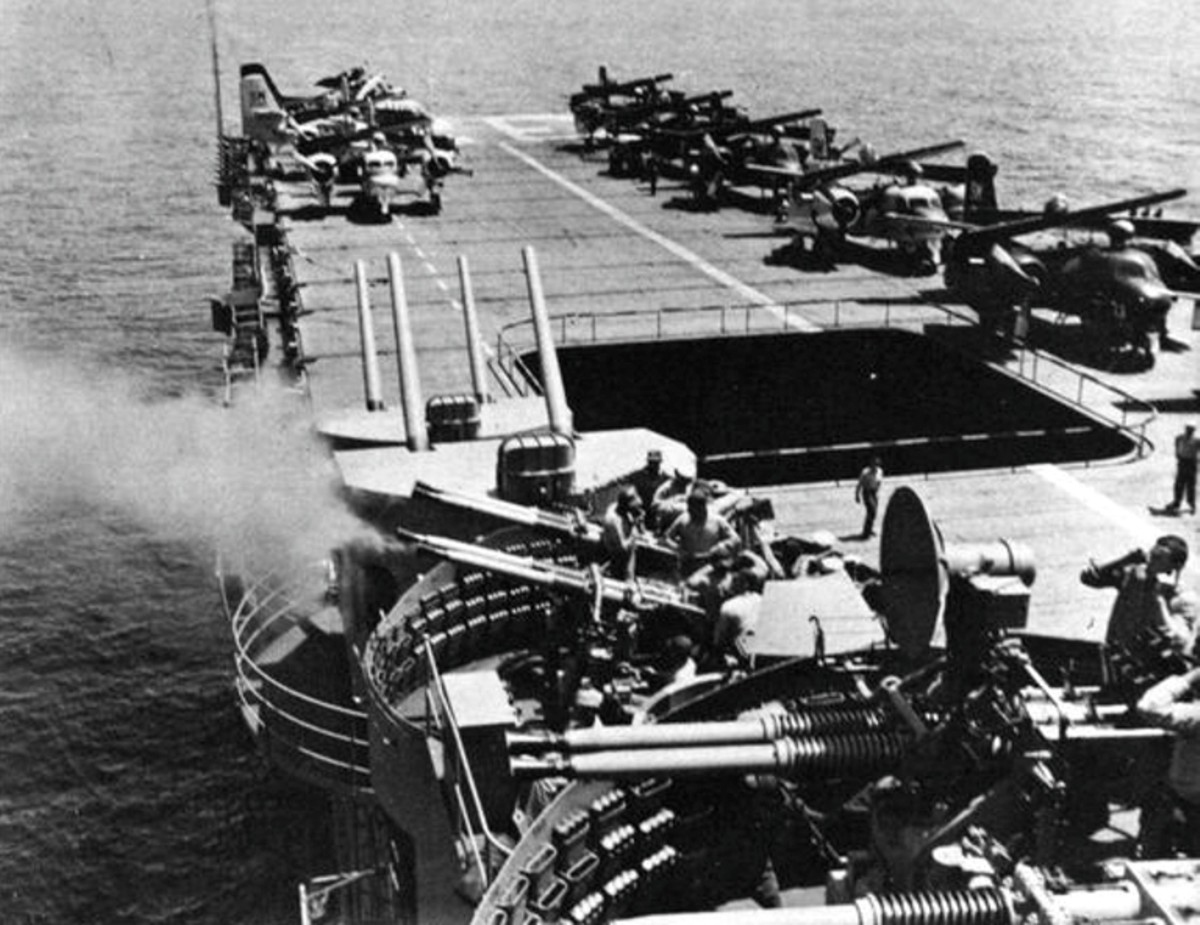 USS Leyte (CVS 32) firing her Bofors 40mm guns - late 1950's 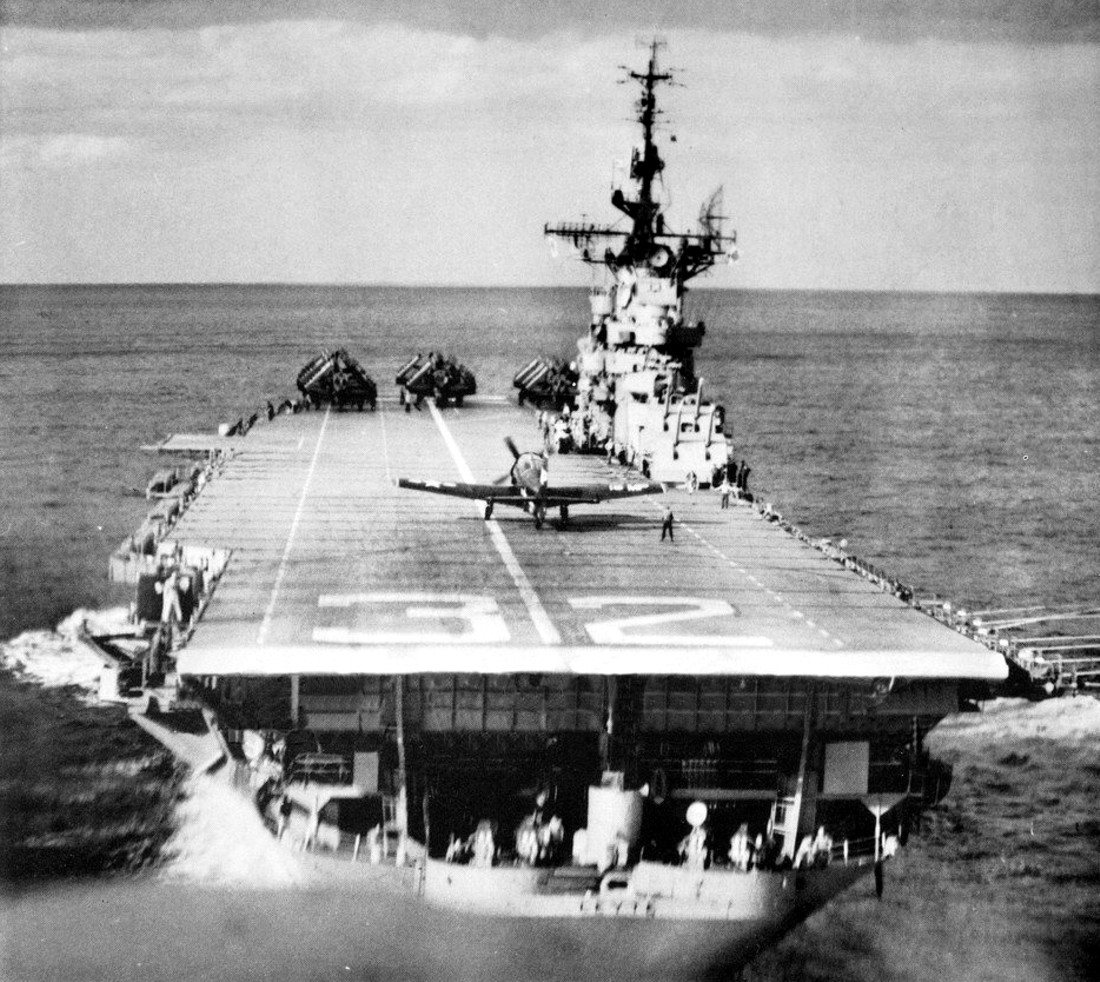 USS Leyte (CVS 32) - circa 1957 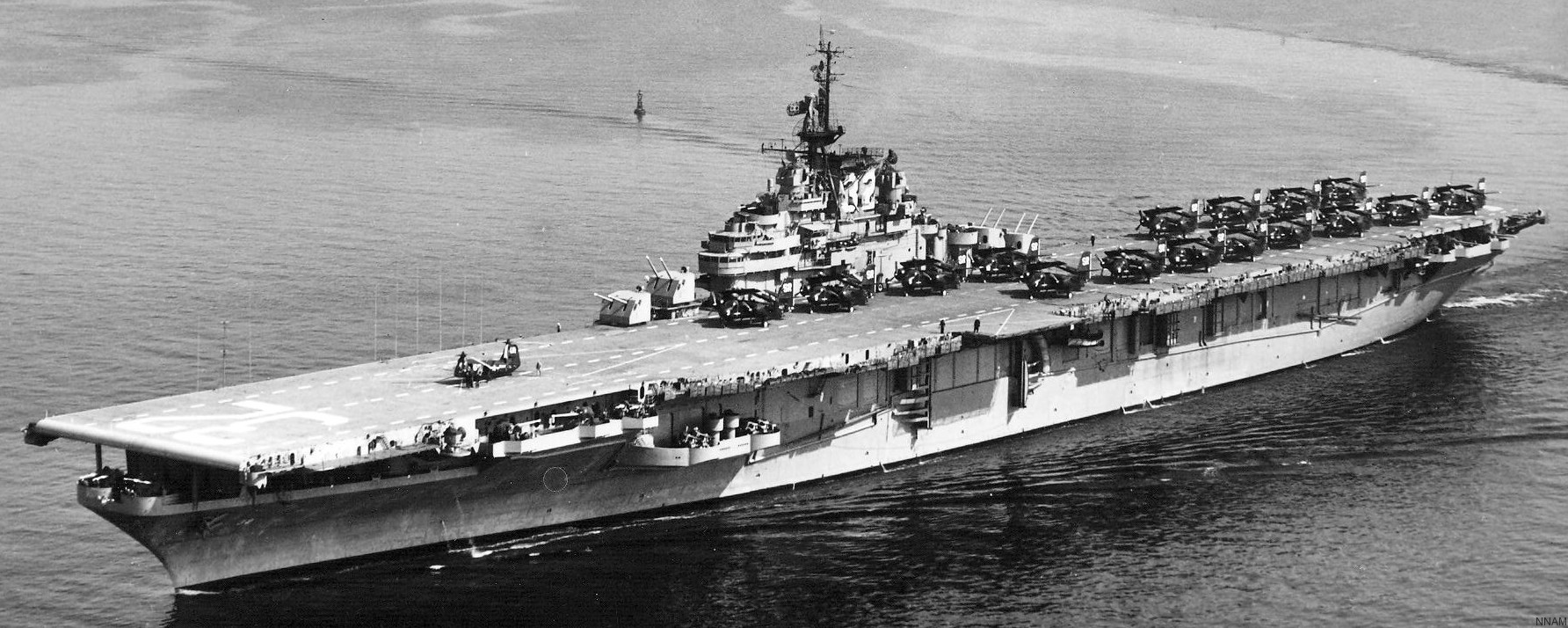 USS Leyte (CVS 32) - circa 1955 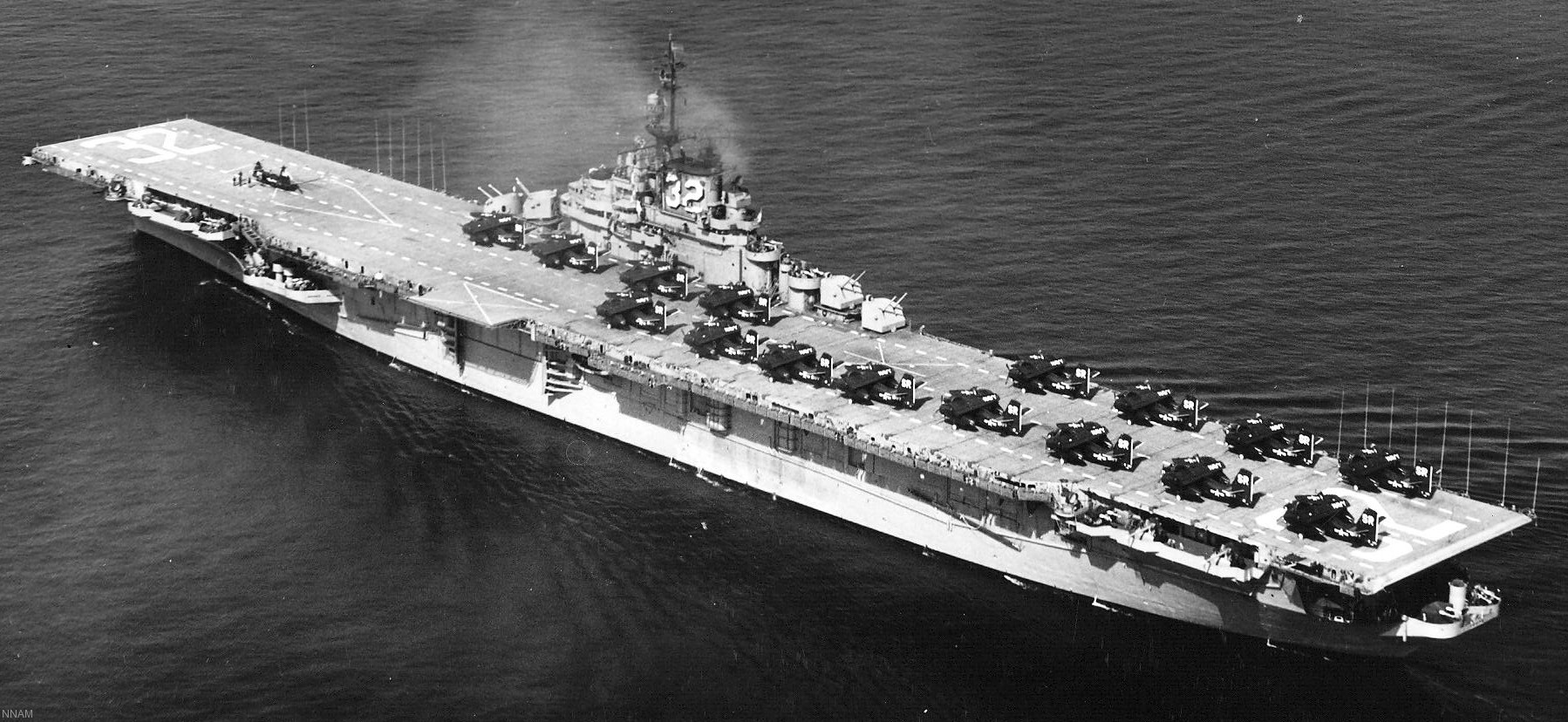 USS Leyte (CVS 32) - circa 1955 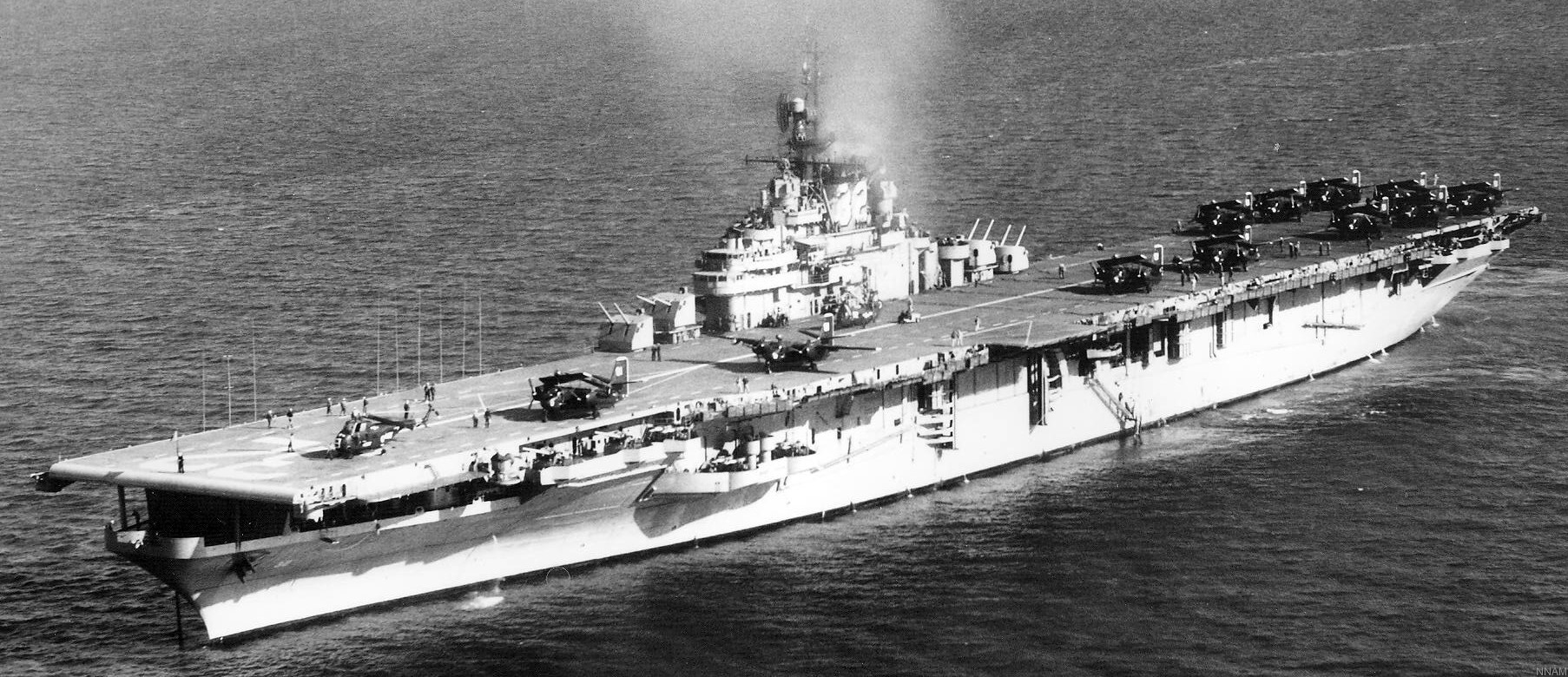 USS Leyte (CVS 32) - circa 1955 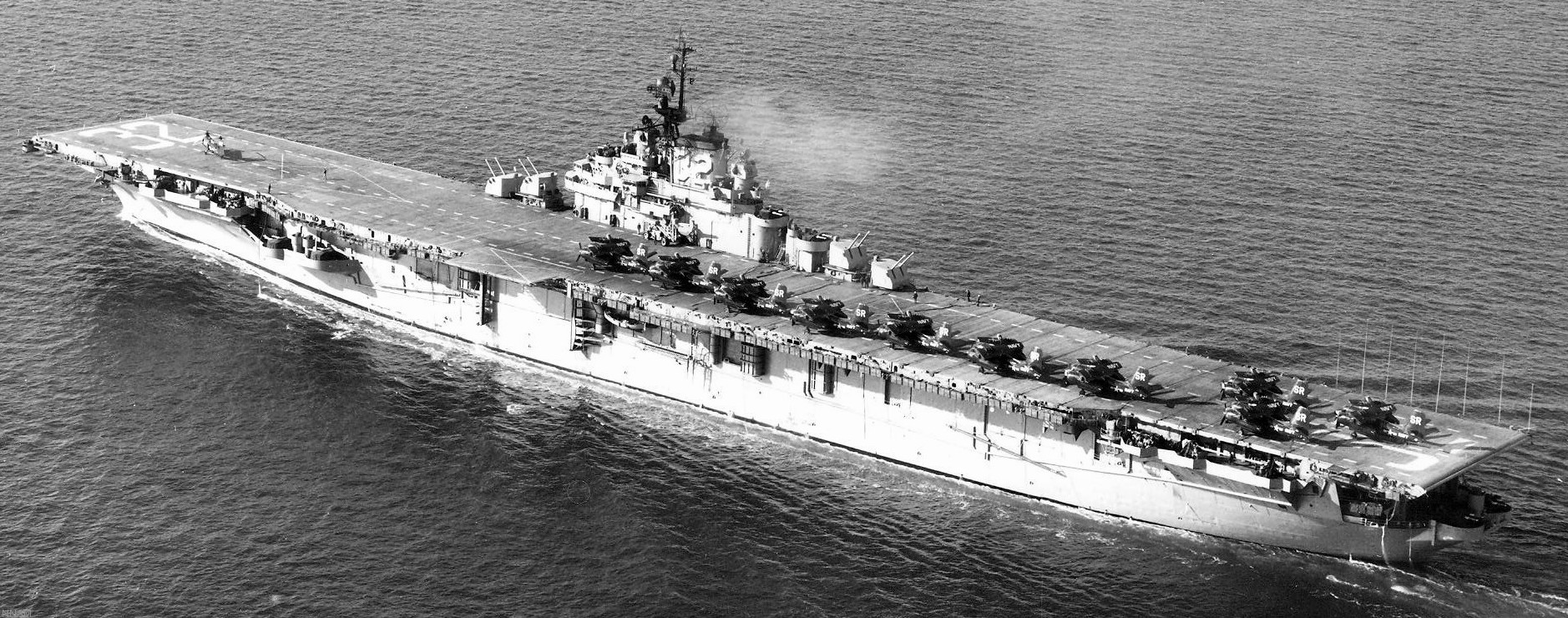 USS Leyte (CVS 32) - circa 1955 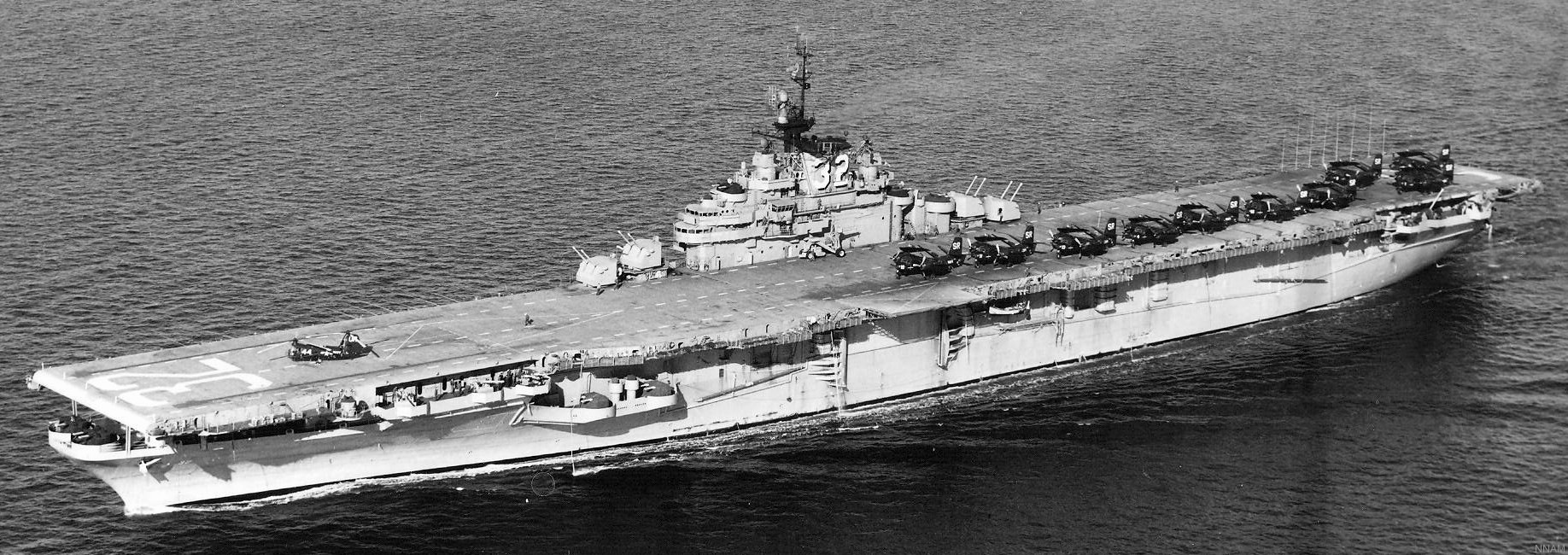 USS Leyte (CVS 32) - circa 1955 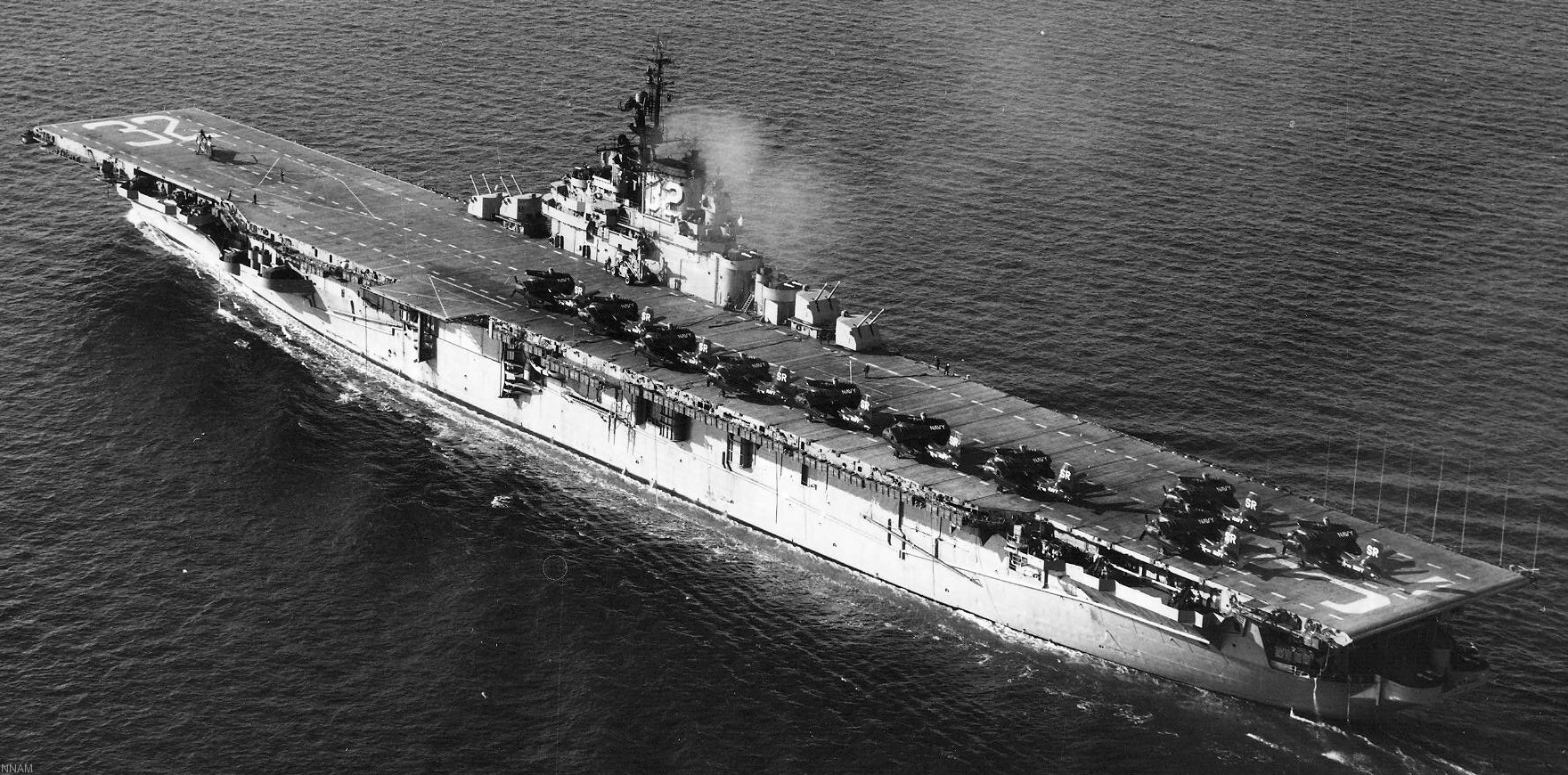 USS Leyte (CVS 32) - circa 1955 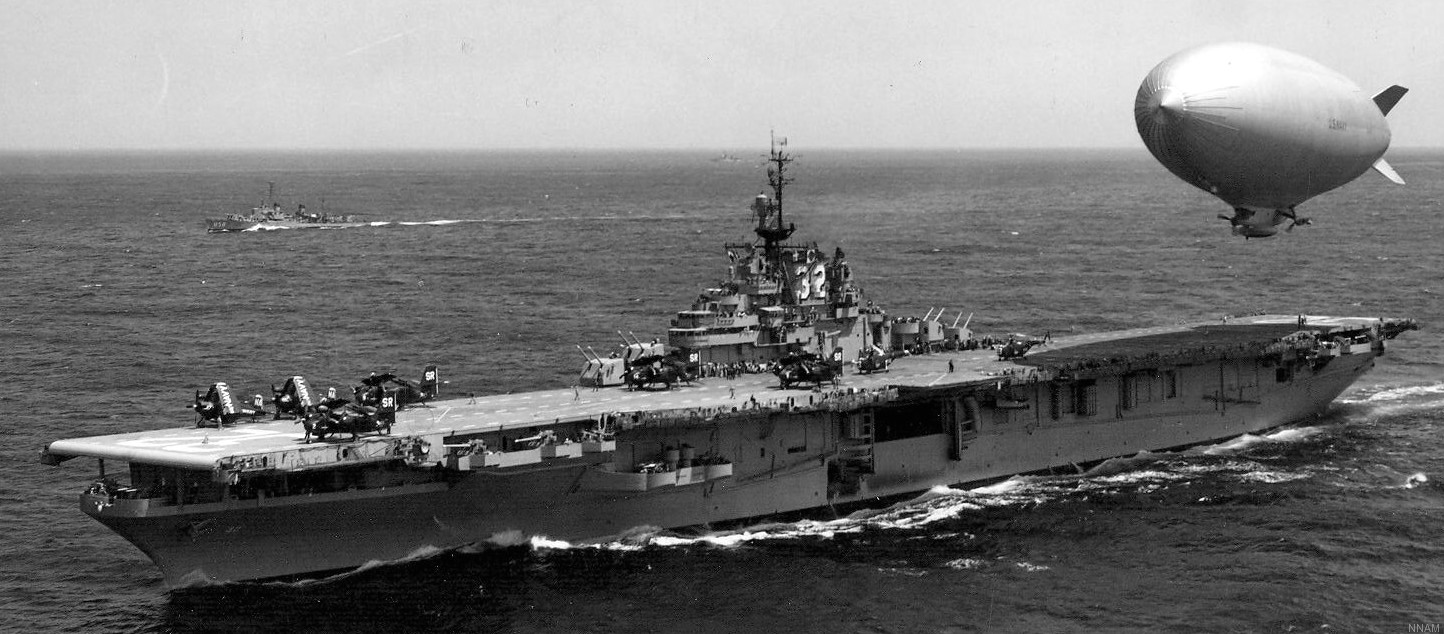 USS Leyte (CVS 32) - May 1955 note the ZPG-2 airship from ZP-3 squadron 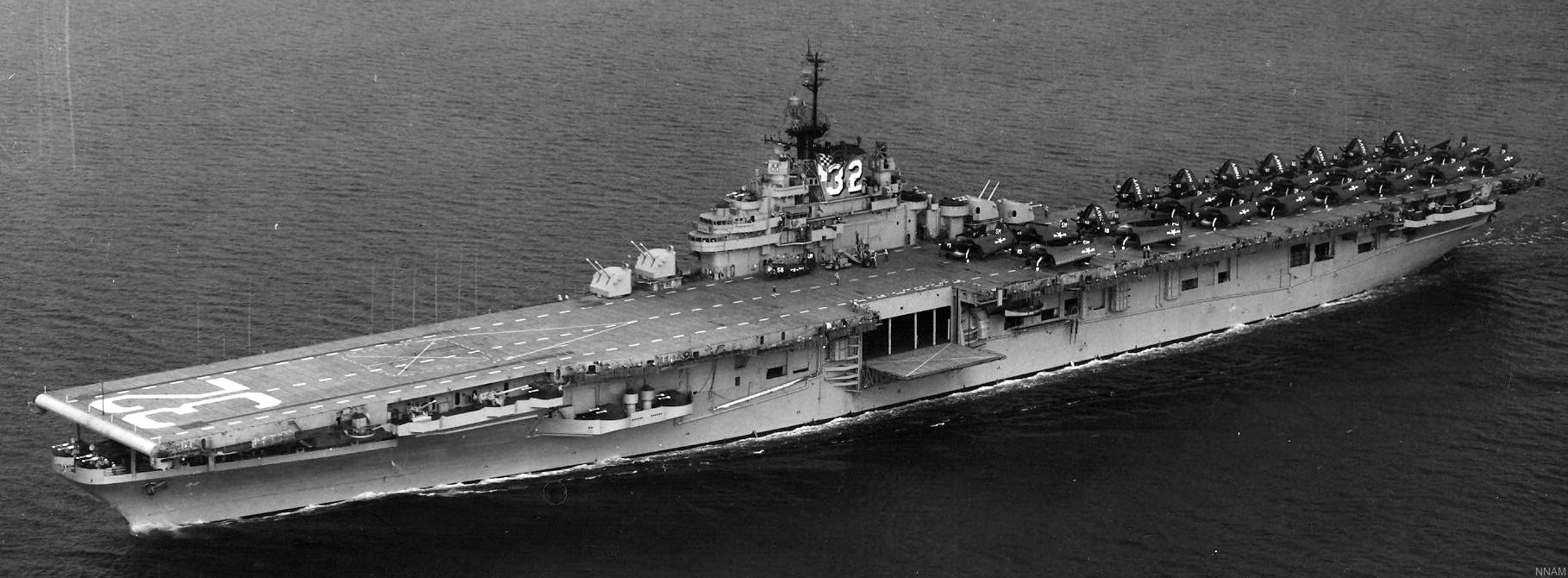 USS Leyte (CVA/CVS 32) - undated reclassified CVS 32 on August 8, 1953 conversion to an Anti-Submarine Carrier (CVS) at Boston Naval Shipyard, Massachusetts -- 8 August 1953 - 4 January 1954 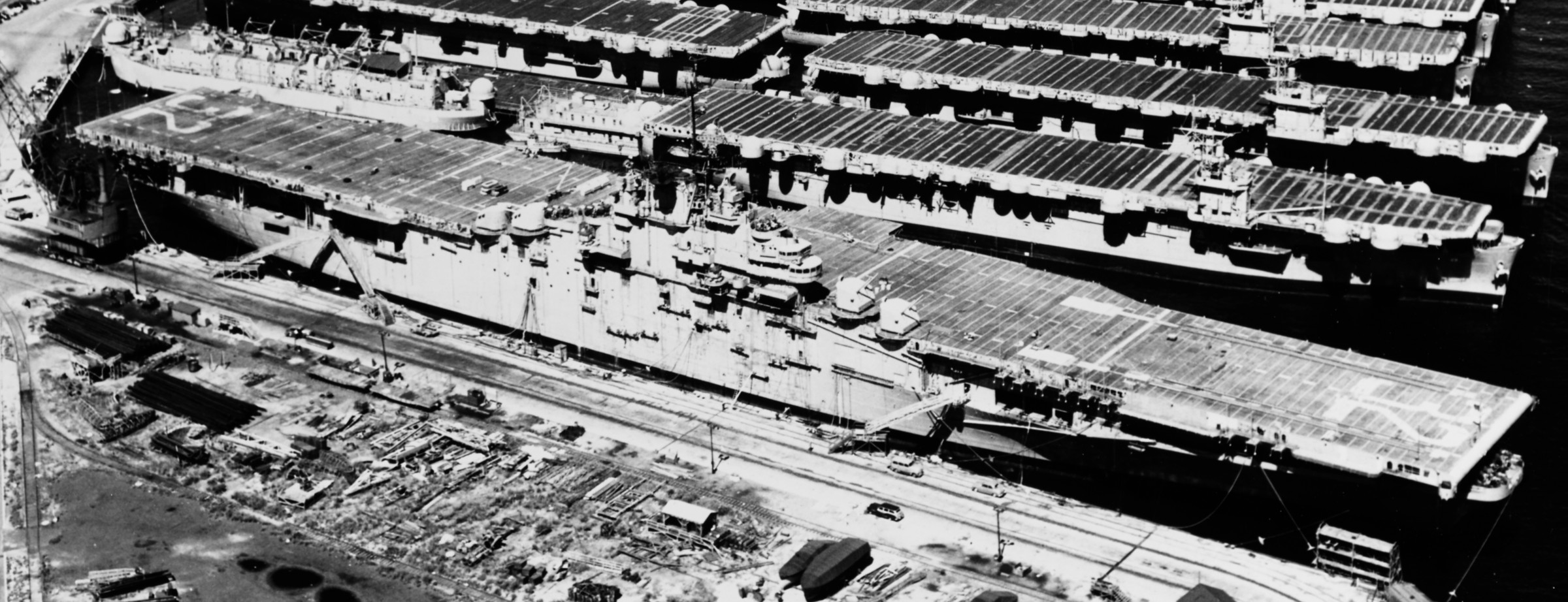 USS Leyte (CVA 32) laid up at the South Boston Naval Annex, Boston Naval Shipyard, Massachusetts - July 1953 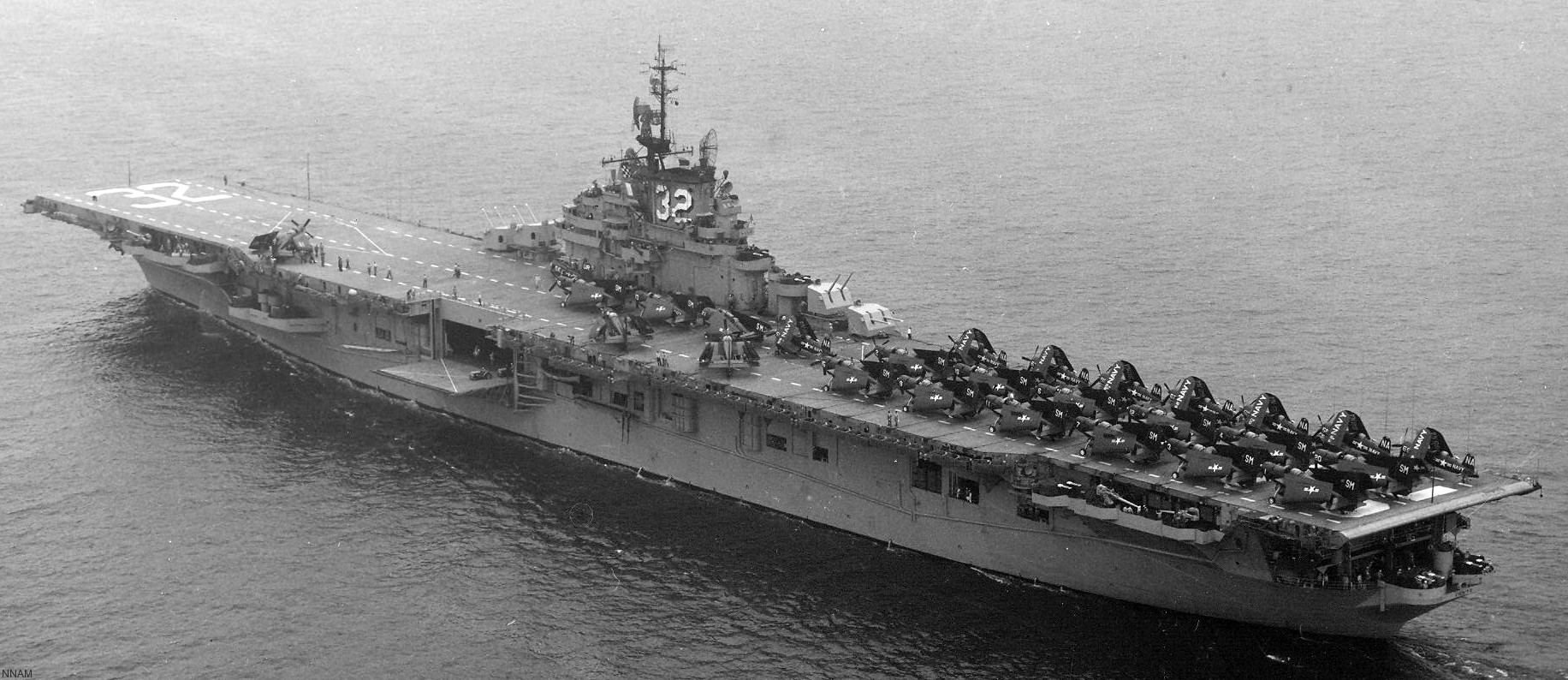 USS Leyte (CVA 32) with Carrier Air Group 3 (CVG-3) embarked - circa 1953 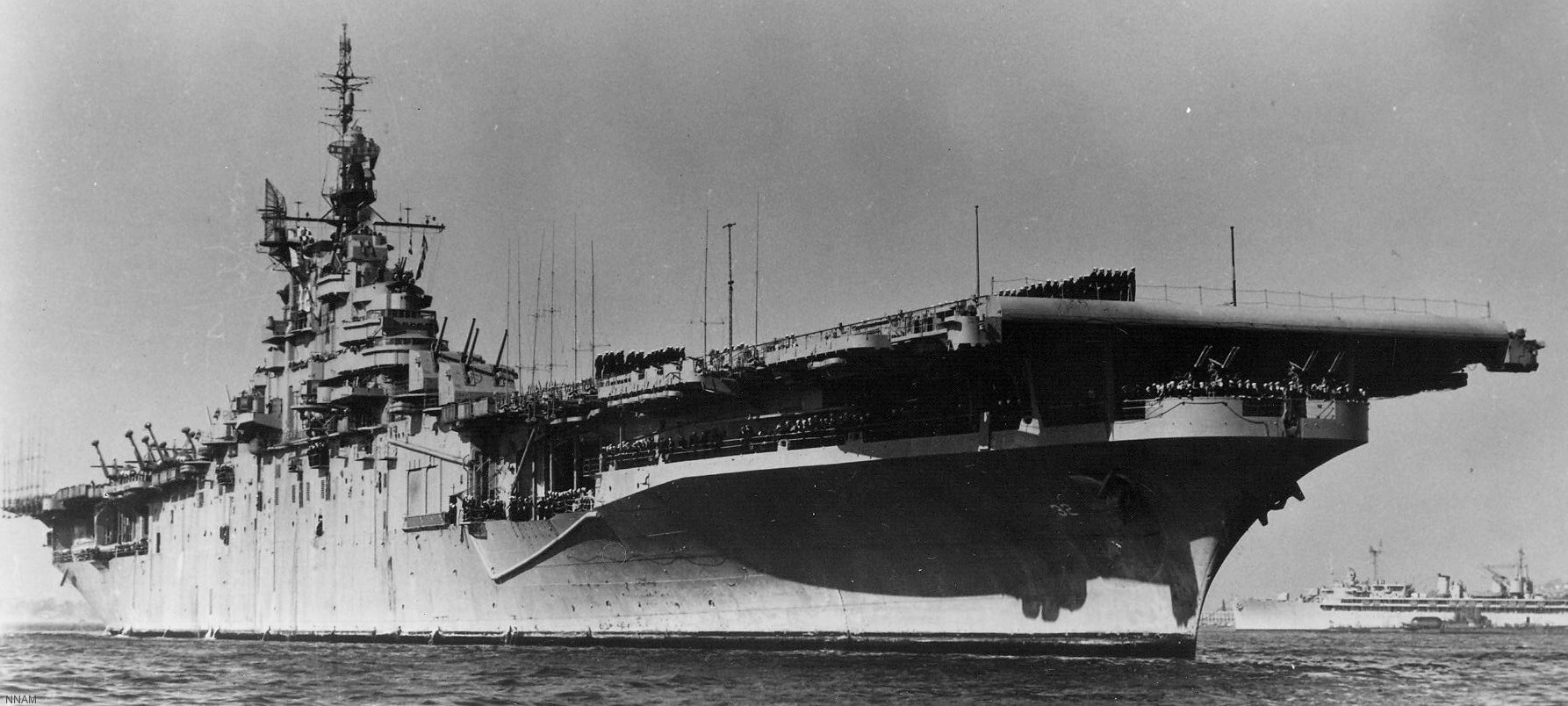 USS Leyte (CVA 32) - circa 1950-53 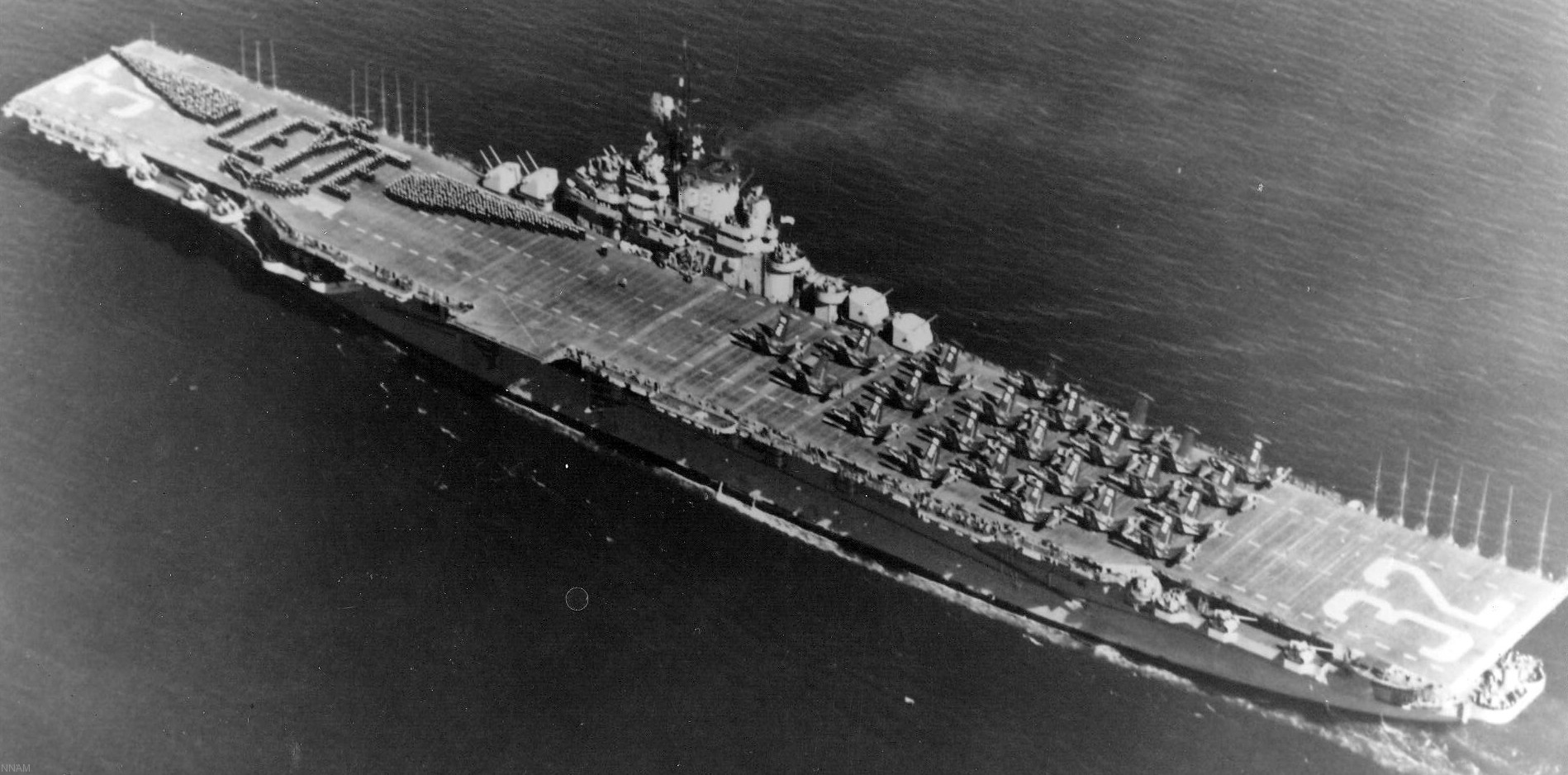 USS Leyte (CVA 32) with Carrier Air Group 3 (CVG-3) embarked - circa 1950-53 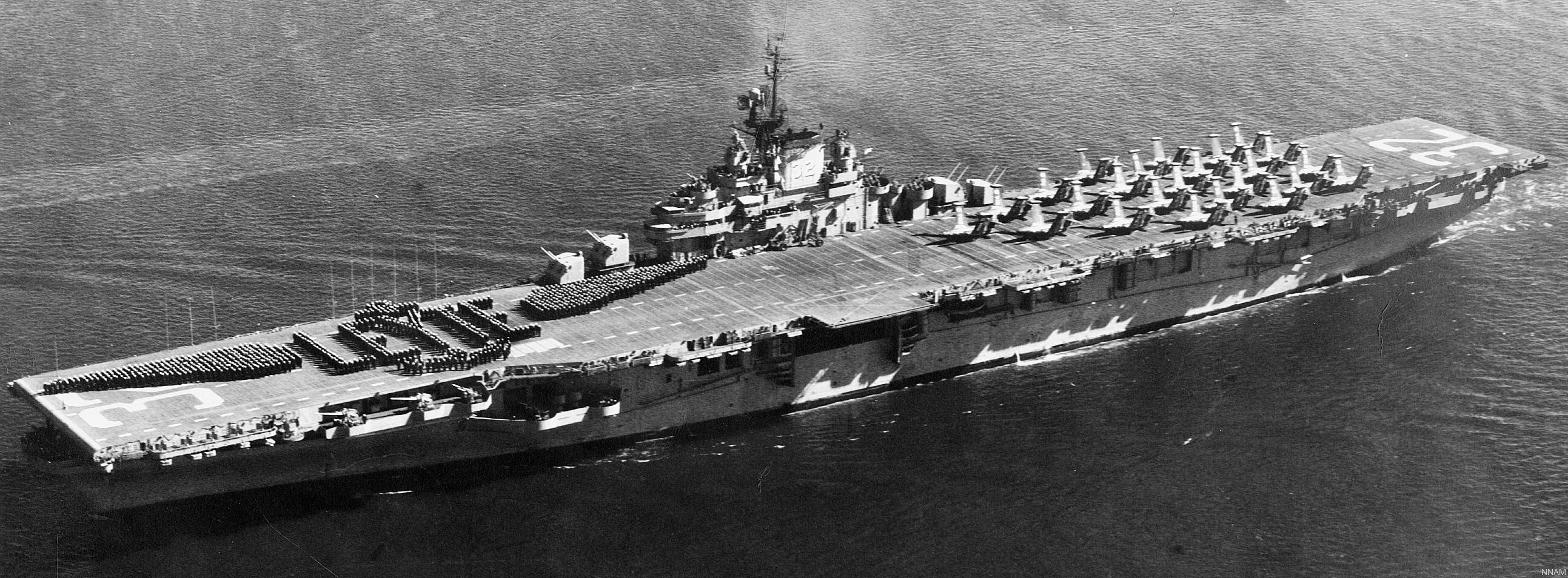 USS Leyte (CVA 32) with Carrier Air Group 3 (CVG-3) embarked - circa 1950-53 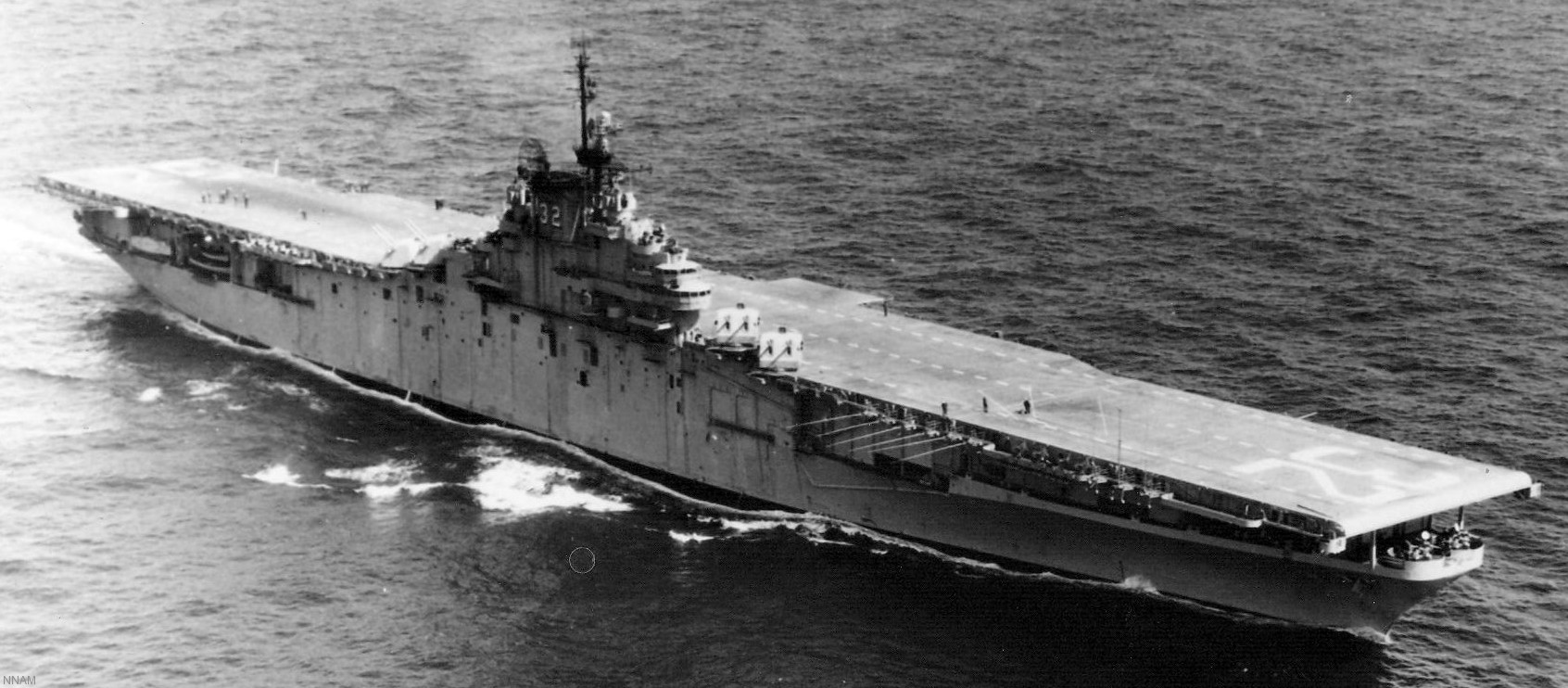 USS Leyte (CV 32) - March 1952  USS Leyte (CV 32) off Mayport, Florida - January 1952  USS Leyte (CV 32) with Carrier Air Group 3 (CVG-3) embarked - Genoa, Italy - circa 1951  USS Leyte (CV 32) with Carrier Air Group 3 (CVG-3) embarked - February 1951 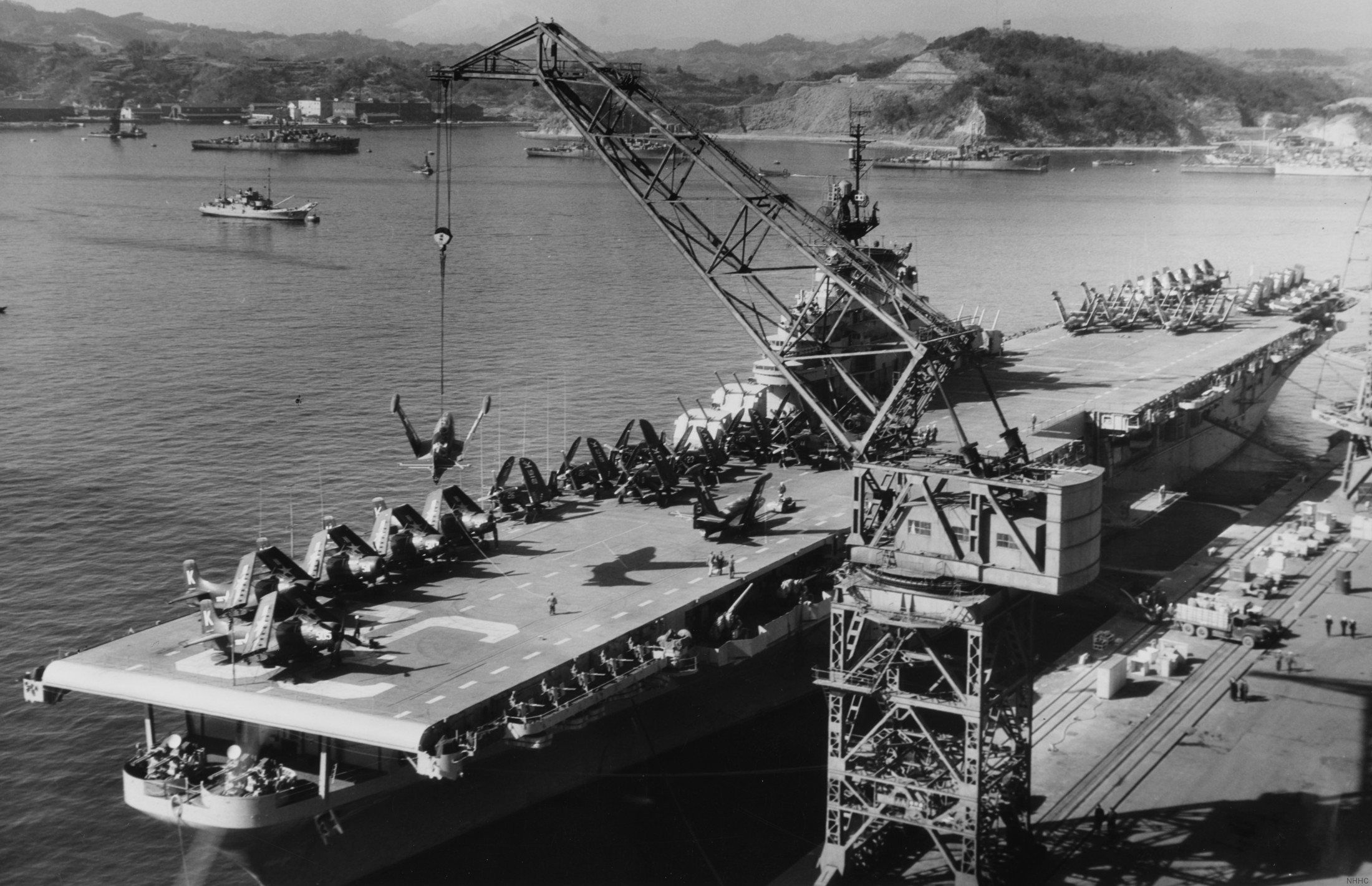 USS Leyte (CV 32) with Carrier Air Group 3 (CVG-3) embarked - Yokosuka, Japan - January 1951 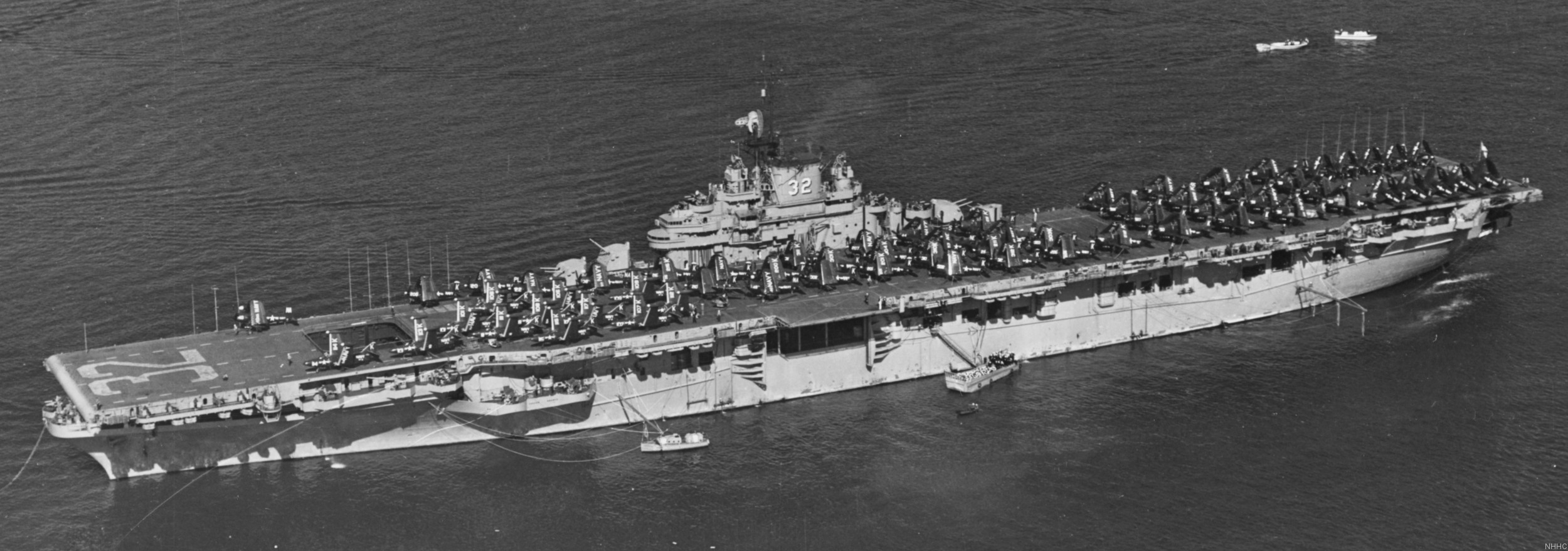 USS Leyte (CV 32) with Carrier Air Group 3 (CVG-3) embarked - Yokosuka, Japan - December 1950 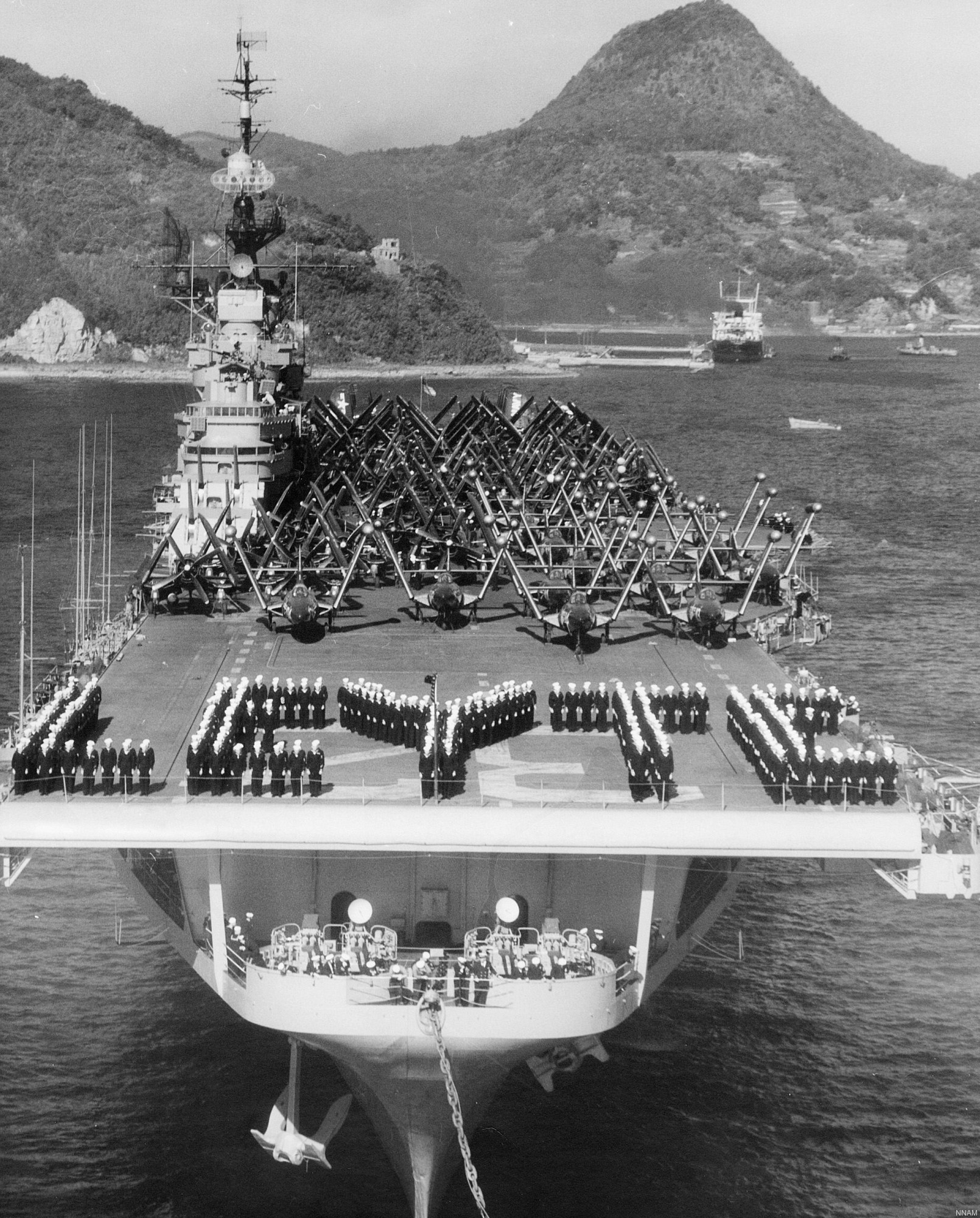 USS Leyte (CV 32) with Carrier Air Group 3 (CVG-3) embarked - Sasebo, Japan - 1950 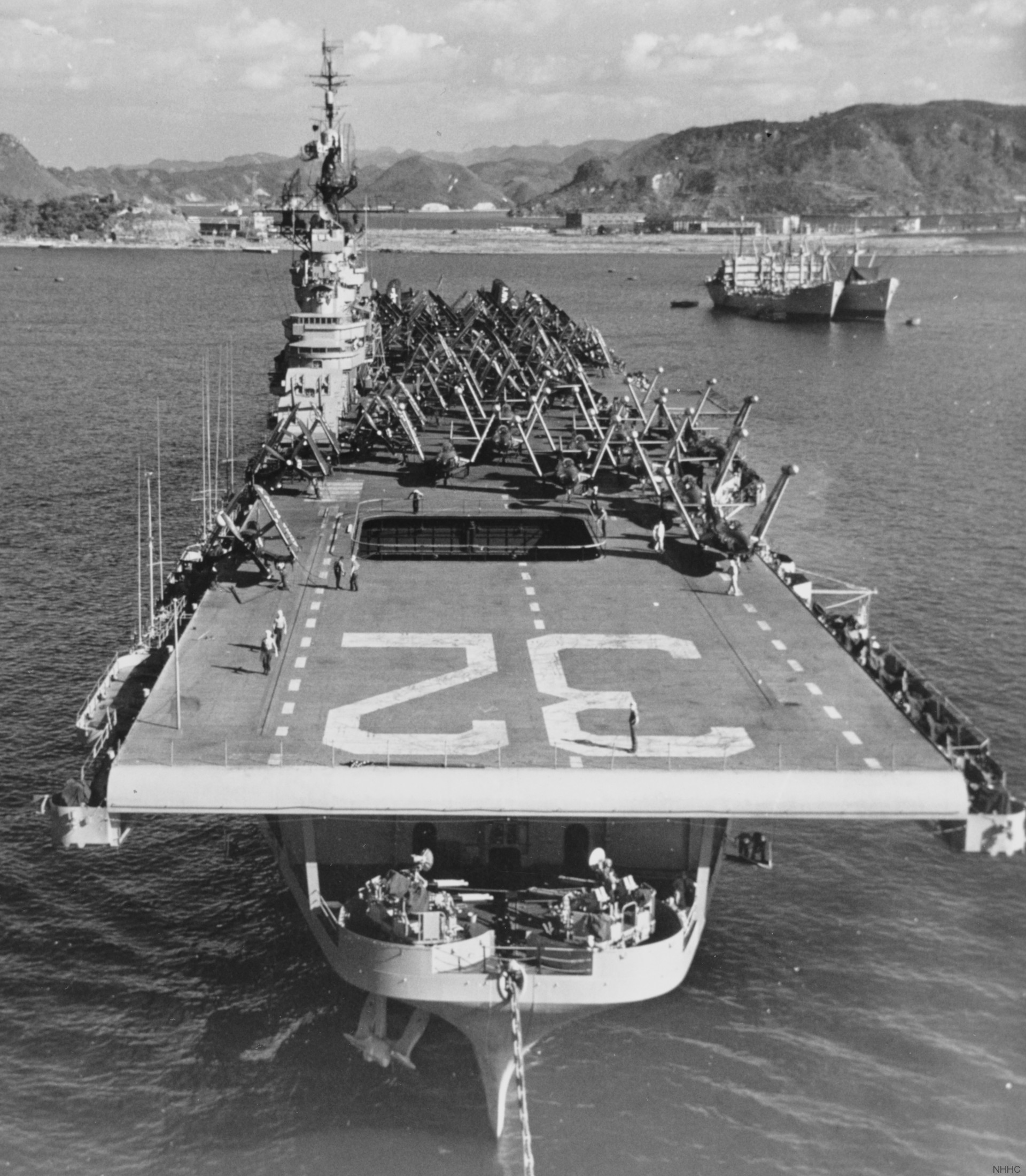 USS Leyte (CV 32) with Carrier Air Group 3 (CVG-3) embarked - Sasebo, Japan - November 1950 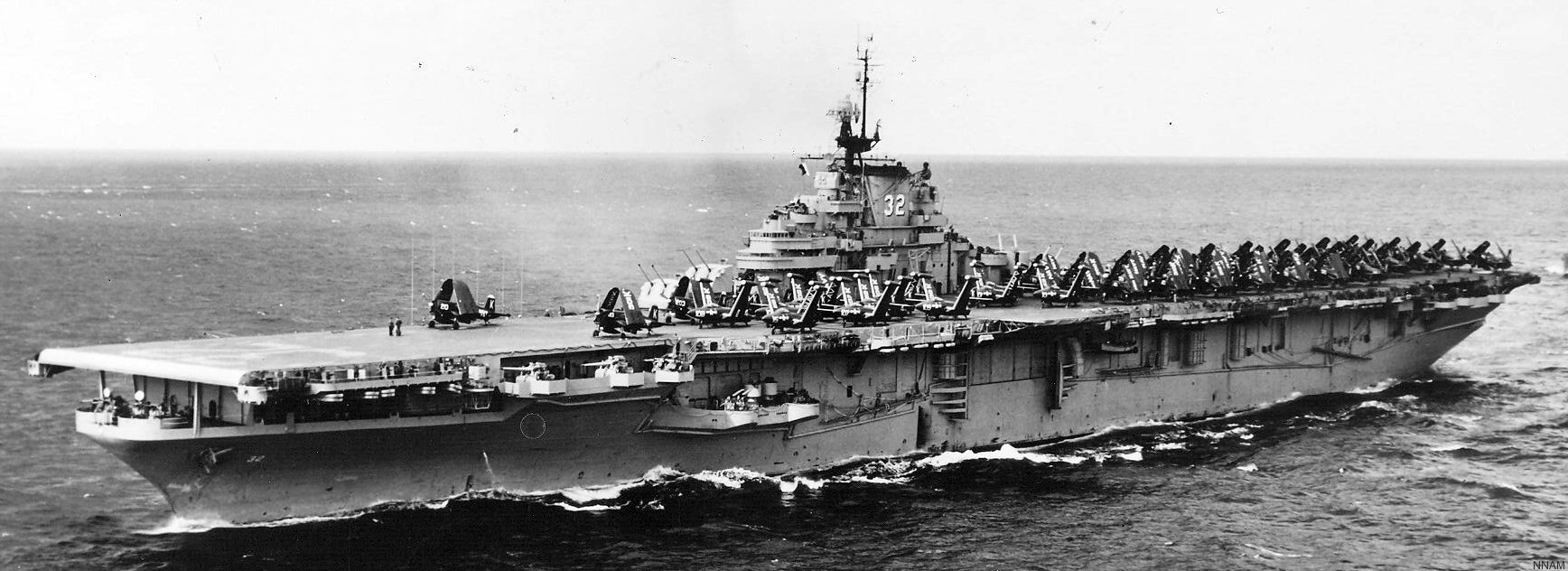 USS Leyte (CV 32) with Carrier Air Group 3 (CVG-3) - November 1950 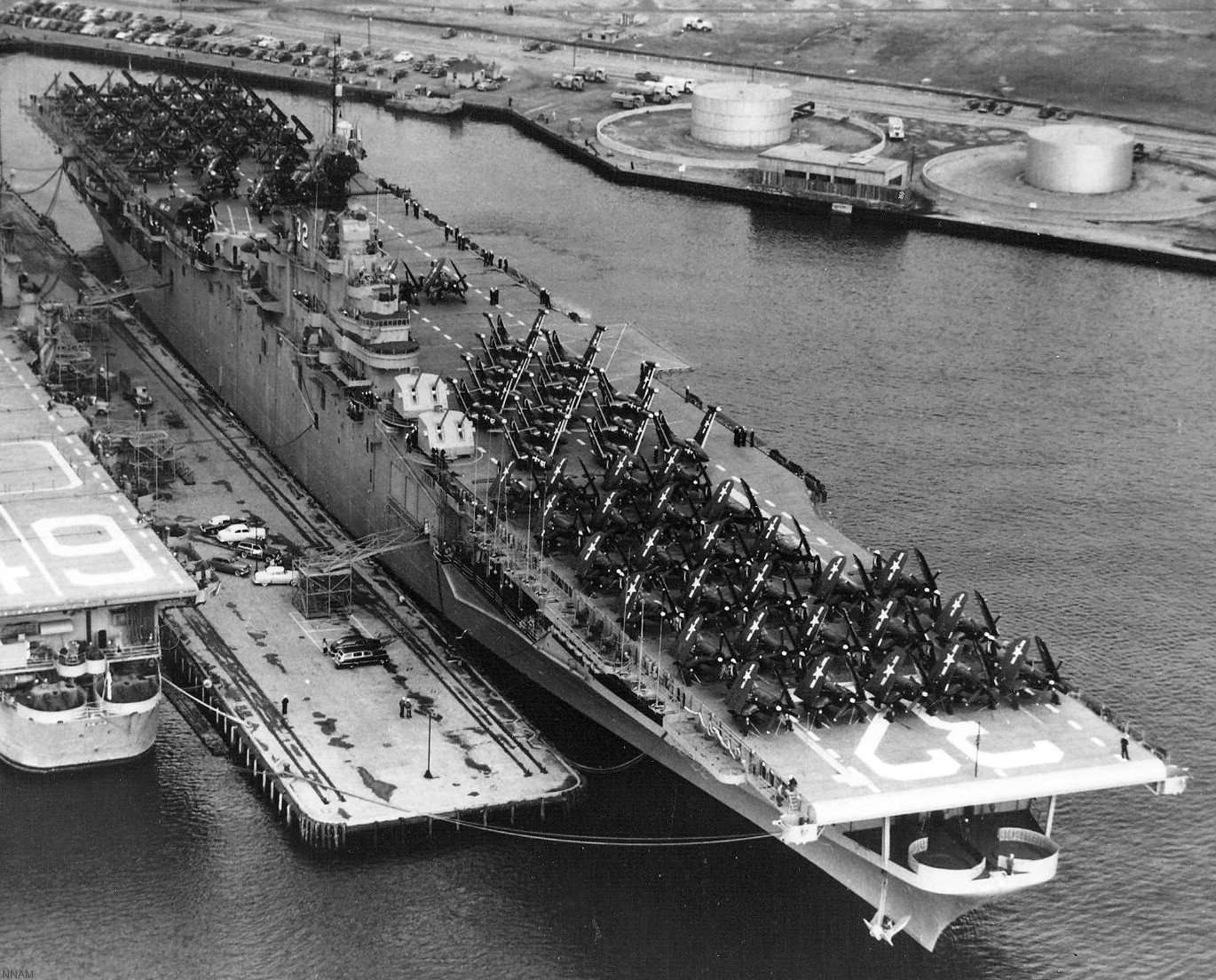 USS Leyte (CV 32) with Carrier Air Group 3 (CVG-3) embarked - NAS Quonset Point, Rhode Island - circa 1950 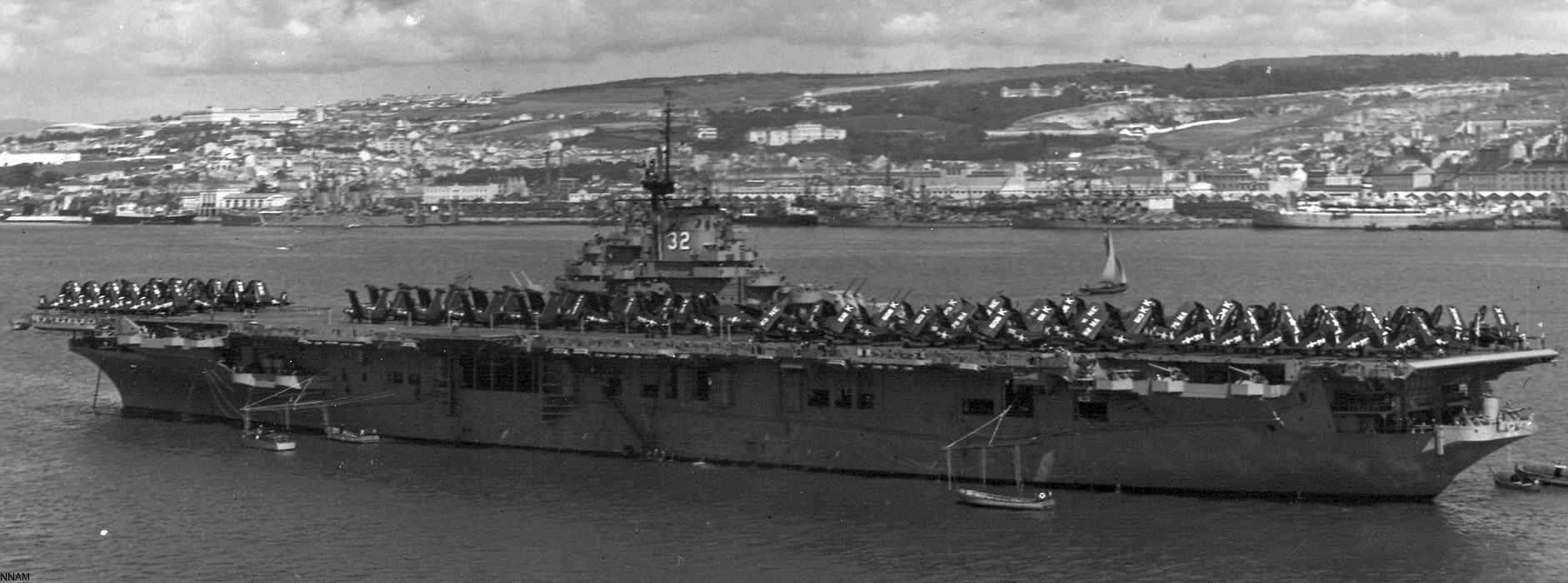 USS Leyte (CV 32) with Carrier Air Group 3 (CVG-3) embarked - circa 1950  USS Leyte (CV 32) - circa 1949 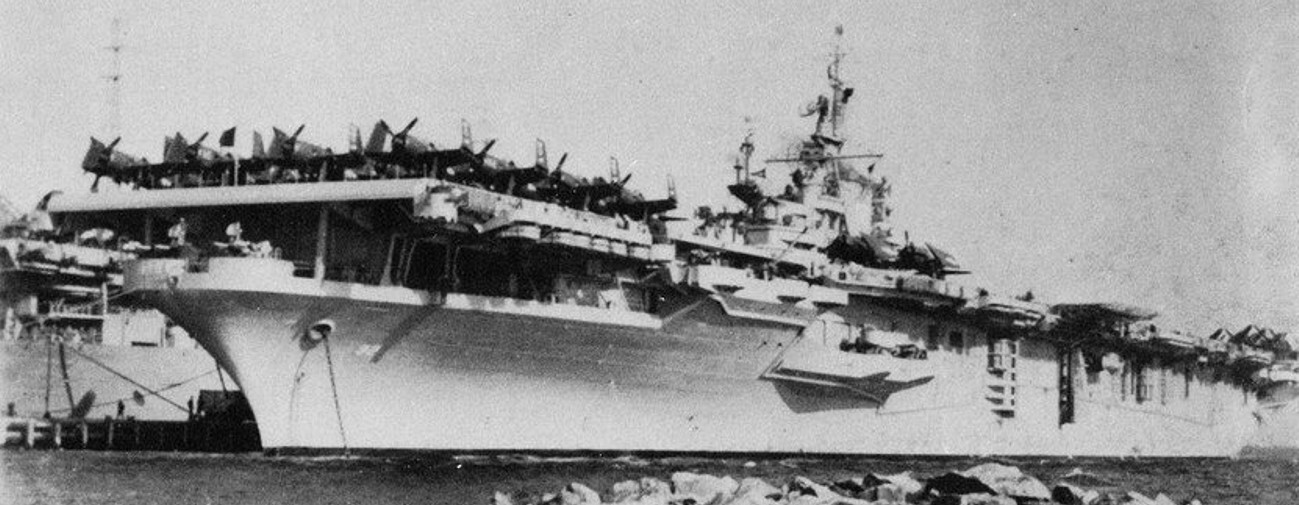 USS Leyte (CV 32) - circa 1949  USS Leyte (CV 32) with Attack Carrier Air Group 7 (CVAG-7) embarked - November 1948 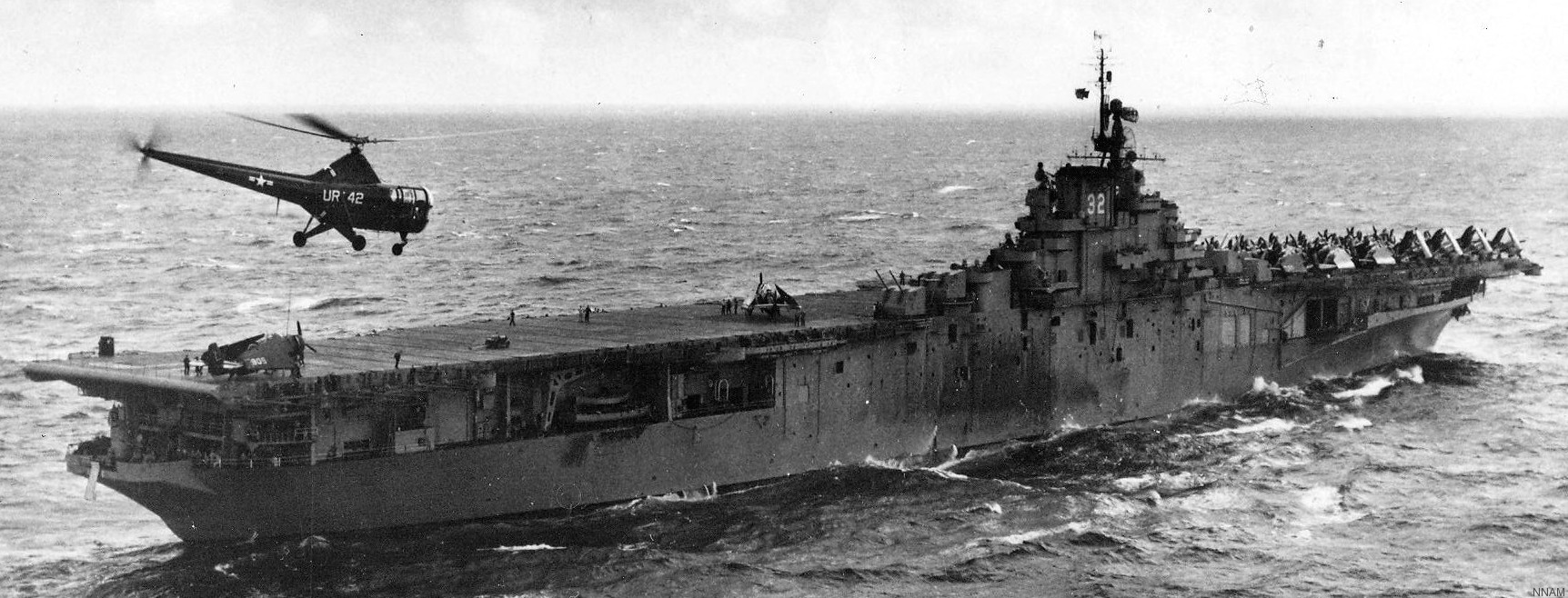 USS Leyte (CV 32) with Attack Carrier Air Group 7 (CVAG-7) embarked - November 1948 note the Sikorsky HO3S-1 Helicopter of HU-2 'Fleet Angels' 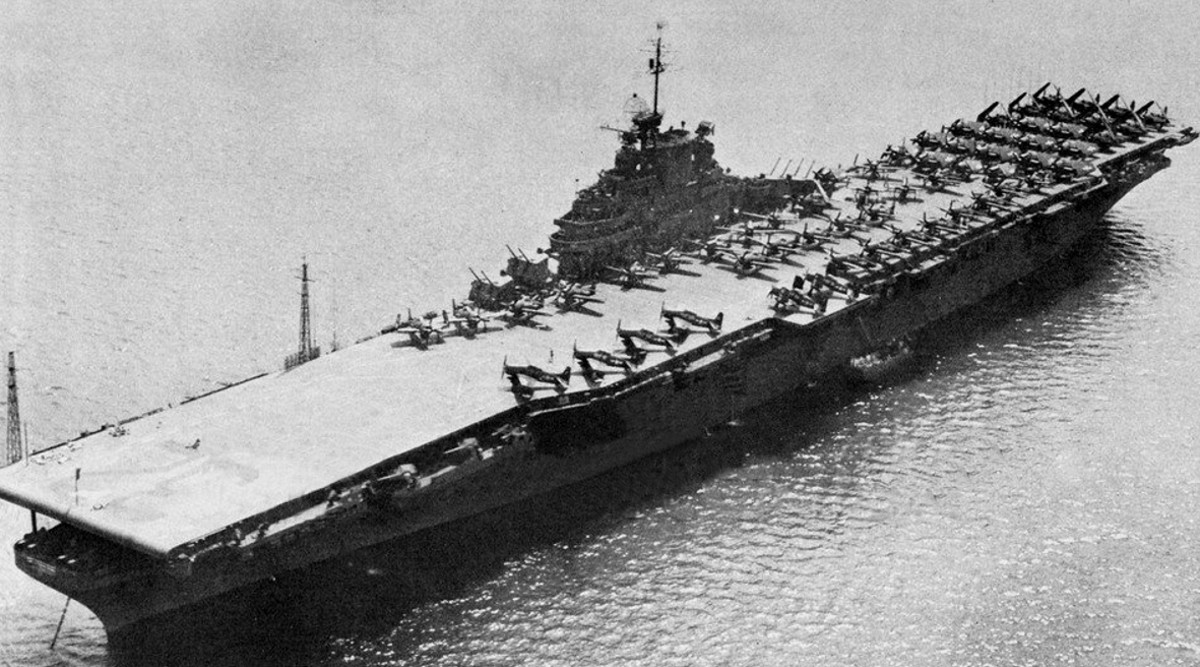 USS Leyte (CV 32) with Carrier Air Group 18 (CVG-18) embarked - off Cuba - 1946  USS Leyte (CV 32) - May 1946 |
||
|
The Battle of Leyte Gulf ... is considered to have been the largest naval battle of World War II and is, by some criteria, a contender for the title "largest naval battle in history", with over 200,000 naval personnel involved. It was fought in waters near the Philippine islands of Leyte, Samar, and Luzon, from 23-26 October 1944, between combined American and Australian forces and the Imperial Japanese Navy (IJN), as part of the invasion of Leyte, which aimed to isolate Japan from the countries it had occupied in Southeast Asia which were a vital source of industrial and oil supplies. By the time of the battle, Japan had fewer capital ships (aircraft carriers and battleships) left than the Allied forces had total aircraft carriers, underscoring the disparity in force strength at this point in the war. Regardless, the IJN mobilized nearly all of its remaining major naval vessels in an attempt to defeat the Allied invasion, but it was repulsed by the U.S. Navy's Third and Seventh fleets. The battle consisted of four main separate engagements: the Battle of the Sibuyan Sea, the Battle of Surigao Strait, the Battle of Cape Engaño and the Battle off Samar, as well as lesser actions. This was the first battle in which Japanese aircraft carried out organized kamikaze attacks, and the last naval battle between battleships in history. The IJN suffered heavy losses and never sailed in comparable force thereafter, stranded for lack of fuel in their bases for the rest of the war, and were unable to affect the successful Allied invasion of Leyte. |
||
|
USS Leyte (CV / CVA / CVS 32 - AVT 10): Crown Point (CV-32) was laid down on 21 February 1944, at Newport News, Va., by the Newport News Shipbuilding & Dry Dock Co.; renamed Leyte on 8 May 1945; launched on 23 August 1945; sponsored by Mrs. Alice M. [Dillon] Mead, wife of U.S. Senator James M. Mead, New York (D); and commissioned at the Norfolk Naval Shipyard, Portsmouth, Va., on 11 April 1946, Capt. Henry F. MacComsey in command. Personnel shortages having impacting the Navy’s being able to fully man its ships delayed Leyte from carrying out her shakedown, but she ultimately departed Hampton Roads, Va., on 30 August 1946 for Quonset Point, R.I., where she embarked Carrier Air Group (CVG) 18. After embarkation, she carried out her carrier qualification landings, then shaped a course for Cuba. She arrived at Guantanamo Bay, Cuba, on 16 September 1946, for shakedown training and then transited the Panama Canal on 20 October, to join the battleship Wisconsin (BB-64) on a good will cruise down the western seaboard of South America. After embarking the Surgeon General of the Chilean Army at Balboa, Chile, she proceeded to Valparaiso, Chile. Her officers and bluejackets attended the Presidential inauguration of President Gabriel Gonzales Videla in Santiago, Chile, before she paid a goodwill call to Callao, Peru. She again transited the Panama Canal on 18 November 1946, to resume shakedown operations that took her to the waters of Cuba and the U.S. Virgin Islands. She stood into Yorktown, Va., on 12 December. On 30 January 1947, the Greek government proclaimed martial law in response to the rising threat posed by communist insurgents during the Greek Civil War. On 21 February, the British announced the reduction of their forces deployed to the eastern Mediterranean Sea and the withdrawal of military assistance to the Greeks and Turks effective on 1 April. U.S. intervention against communist expansionism in the ensuing power vacuum saw Leyte, as flagship of Carrier Division (CarDiv) 4, deployed to the Mediterranean from 3 April to 9 June 1947. This deployment saw a visit by Leyte to Greece, on 16 April, as a show of support for that country’s government. Shortly afterward, again as a result of ongoing Soviet pressure, this time against Turkey, and the British withdrawal from the eastern Mediterranean, U.S. ships including Leyte made a show of support for the Turkish government during a week-long visit to Istanbul beginning on 2 May. She also made port visits to Alexandria, Egypt, Naples, Italy, and Gibraltar. After a brief return to the United States, Leyte again deployed to the Mediterranean (30 July - 19 November 1947). During this second cruise, she made port visits to Gibraltar; Algiers, Algeria; Golfe Juan, France; Izmir, Turkey; Naples; Taranto, Italy; and Athens, Greece. Upon her return to the U.S. she underwent a period of maintenance, then conducted fleet exercises and training of Naval Reservists in the United States and Caribbean. She went back to sea in February 1948 for fleet maneuvers in the Caribbean, during which she made port visits to Trinidad and Tobago and Panama. Leyte returned to the U.S. and entered New York Naval Shipyard and underwent four months of regular inspection and overhaul. Leaving the yard on 28 August, the ship spent two weeks in the waters around Guantanamo Bay, and then steamed to the frigid climes of the Davis Strait between Greenland and Canada to conduct cold weather flying tests in Operation Frigid. Leyte, in January 1949, returned to the Caribbean and operated in the vicinity of Guantanamo Bay with 700 Naval Reservists embarked for a brief indoctrination cruise. During the next two months, she conducted fleet maneuvers and made port visits to Trinidad and Tobago. After a short visit to New York, she returned to Quonset Point. She visited the U.S. Naval Academy at Annapolis, Md. for a week in May and then spent the next six weeks conducting visits to Bayonne, N.J. and Norfolk, Va. before returning to Quonset Point. From 7-25 July, she conducted two short cruises for Naval Academy and Naval Reserve Officer Training Candidate (NROTC) midshipmen out of Newport, R.I. and then spent the month of August at Quonset Point, painting ship and taking on supplies for her third Mediterranean deployment (6 September 1949 - 26 January 1950). During February - March 1950, Leyte participated in Operation Portrex off Puerto Rico and then returned to Norfolk for an accelerated three-week overhaul. Leyte made a fourth deployment in her short career to the Mediterranean from 2 May - 24 August 1950. She made port visits to Lisbon, Portugal; Augusta Bay, Italy; Naples, Leghorn, Italy, the French Riviera, Athens; Greece; Izmir; and Beirut, Lebanon. While visiting Beirut, Leyte and Midway (CVB-41), at the request of the Lebanese government, launched a demonstration of U.S. air power over the Lebanese capital on 14 August, as further evidence of the U.S. support against communism in the Middle East. While off Beirut, the ship received word that she was needed to support United Nations forces in Korea. She hurried to Norfolk where she stood in to port on 24 August. After 15 days of preparations, she cleared Hampton Roads on 6 September bound for the western Pacific. Leyte maintained an average speed of 23 knots on the fast voyage via the Panama Canal to join the Fast Carrier Task Force (TF) 77 in the Far East. Leyte arrived at Sasebo, Japan, on 8 October 1950 and after reporting to Commander, Seventh Fleet, was engaged in combat operations the next day. From 9 October 1950 through 19 January 1951, the ship and her aircraft spent 92 days at sea and flew 3,933 sorties against North Korean targets. Her first strikes against targets in Korea were in support of landing operations around Wonsan. In the course of her deployment, Leyte’s pilots accumulated 11,000 hours in the air while inflicting massive damage upon enemy positions, supplies, transportation, and communications. Having supported the Wonsan operations in October, her squadrons conducted bombing raids against the bridges over the Yalu River between North Korea and China. Ens. Frederick C. Weber of Leyte’s VF-31 piloted a Grumman F9F-2 Panther credited with one of the first kills of a MiG-15 fighter on 18 November 1950. Of particular note, on 4 December 1950, Ens. Jesse L. Brown of VF-32 - the first African American to complete the Navy’s basic flight training program for pilot qualification and to be designated a naval aviator - embarked on board Leyte. Brown flew a Vought F4U-4 Corsair over Hagaru-ri, North Korea, in close support of the hard-pressed Marine Corps and Army forces around the Chosin Reservoir [Changjin Lake]. Antiaircraft fire struck the Corsair, forcing Brown to make an emergency landing beyond Chosin. In gathering darkness and falling temperatures, Lt. (j.g.) Thomas J. Hudner, his wingman, circled Brown to “protect him from enemy troops infesting the area.” Next, “fully aware of the extreme danger in landing on the rough mountainous terrain and the scant hope of escape or survival in subzero temperature,” Hudner made a wheels-up landing nearby. Working against time, Hudner attempted to pull Brown from the burning wreck. With the buckled fuselage trapping the pilot’s legs, Hudner packed snow around Brown to protect him from the flames and returned to his plane to radio for a rescue helicopter equipped with an axe and a fire extinguisher. A Sikorsky HO3S-1 from Marine Observation Squadron (VMO) 6, flown by 1st Lt. Charles C. Ward, USMC, responded but after repeated unsuccessful attempts by both men to free Brown, had to leave him with the onset of nightfall. Brown, unfortunately, died, but Ward rescued Hudner, who subsequently received the Medal of Honor for his attempt to rescue his wingman. Ward received the Silver Star for his volunteering for the rescue flight although he knew full well the hazards of the mission that would need to be carried out in gathering darkness. Leyte, having provided close air support for operations around the Chosin Reservoir, also assisted with retrograde and evacuation operations around Hungnam, North Korea. She was at Sasebo (26 December 1950 - 7 January 1951) and then returned to Korean waters to help U.S. Army units hold the strategic town of Wonju in central Korea. She was detached from the Seventh Fleet on 19 January 1951 and ordered to return to the U.S. Steaming back home, Leyte returned to the Norfolk Naval Shipyard for overhaul, steaming via San Diego, Calif. (3 February) and the Panama Canal, on 25 February. With her repairs complete, Leyte conducted six weeks of fleet training exercises in the Caribbean which terminated at Norfolk on 21 August 1951. She departed for a return to the Mediterranean, her fifth deployment, on 3 September. Leyte completed her duty with the Sixth Fleet and returned to Norfolk on 21 December to conduct operations out of Hampton Roads. Prior to steaming again for the Mediterranean on 29 August 1952, she was redesignated CVA-32. This sixth deployment lasted through the New Year during which she was again redesignated, this time as CVA-32. With her sixth Mediterranean deployment completed, she returned to the U.S. at the Boston Naval Shipyard on 16 February 1953 in preparation for her expected deactivation. On 8 July 1953, however, the designation Anti-Submarine Support Aircraft Carrier (CVS) was established for attack carriers assigned to hunt submarines. The decision became effective on 8 August, and from this date, the five assigned carriers, not all operational, were redesignated Leyte (CVS-32), Enterprise (CVS-6), Franklin (CVS-13), Bunker Hill (CVS-17), and Antietam (CVS-36). Ordered to be retained in the active fleet; and, redesignated CVS-32 on the same day, work was begun converting her to an ASW support carrier. On 15 October 1953, at 1515, while still under conversion, Leyte suffered an explosion in her port catapult machinery room. Within minutes, naval base and city fire trucks were on the scene. After a hard and gallant fight, where acts of heroism were legion, the fire was extinguished at 1957. As a result of the fire, 37 men died and 28 were injured, the number including civilian workmen who were on board when the fire began. Leyte’s conversion was completed on 4 January 1954, and she thus became the initial operational antisubmarine warfare carrier. After refresher training based on Guantanamo Bay, Leyte took part in the Atlantic Fleet’s spring training exercises in the Caribbean and conducted the convoy exercise New Broom III to Lisbon, Portugal. She also introduced the then new Grumman S2F Tracker antisubmarine type aircraft to the fleet while playing the role as the nucleus of a hunter-killer force comprising herself, as flagship, her embarked air groups, and an escorting squadron of destroyers. Leyte departed Quonset Point on 5 January 1956 and steamed to New York. Entering the yard on 8 January she underwent a maintenance availability until 21 June. After returning to Quonset Point on 22 June, she departed on 5 July for the Caribbean to conduct training. She returned to Quonset Point on 30 August. Later in the year she served as the flagship for Task Group 81.4 conducting antisubmarine patrols in the North Atlantic through the end of November. Having returned to Quonset Point, she remained there through the end of the year. Leyte’s proficiency in antisubmarine warfare (ASW) was recognized in August 1958 when she received the Battle “E” Award as the outstanding ship of her class. Throughout most of her service as an antisubmarine warfare support aircraft carrier, she served as the CarDiv 18 flagship. Operating out of Quonset Point, with her hunter-killer force, she carried out a constant schedule of ASW tactics training with U.S. submarines based from New London, Conn., in areas along the U.S. eastern seaboard and into the Caribbean. On Saturday, 27 December 1958, Lt. (j.g.) Charles G. Lukitsch, of VS-30, carried out the last operational landing on board Leyte, the ship’s 69,700th. Leyte departed Quonset Point in January 1959 for the New York Naval Shipyard, where she commenced pre-inactivation overhaul. She was decommissioned at New York on 15 May 1959 and placed in reserve. That same day, she was redesignated as an auxiliary aircraft transport, AVT-10, a description that “properly describe[d] her mobilization capability in her present configuration.” She was assigned to the Philadelphia group of the Atlantic Reserve Fleet with a berth in New York. Naval Supply Center (NSC), Bayonne, N. J., assumed temporary custody of Leyte and Franklin (AVT-8), the latter having been redesignated as an auxiliary aircraft transport as well, on 25 August 1962. Having been moved to the graving dock at the Military Ocean Terminal (MOT) (formerly the Naval Supply Center), Bayonne, Leyte underwent an inspection by a sub-board of inspection and survey (3-6 March 1969) that found her “unfit for further service.” The sub-board recommended, on 12 March 1969, that the ship be stricken from the Naval Vessel Register (NVR). Consequently, Leyte was stricken from the NVR on 1 June 1969. Although the ship was offered to the city of Pensacola, Fla., to serve as a memorial, various circumstances compelled the city to refuse the Navy’s offer. The removal of her machinery and equipment was completed on 20 February 1970. She was sold at public sale to the Portsmouth Salvage Co., Chesapeake, Va., for scrapping on 4 August 1970. Turned over to the purchaser, the ship was removed from the MOT and naval custody at 2210 on 24 September 1970 and began her last voyage to the breakers’ yard. Leyte received a Navy Unit Commendation (for the period 9 October 1950 to 9 January 1951) and two battle stars for her Korean War service. source: US Naval History & Heritage Command - - - - - another history: Leyte was one of the "long-hull" Essex-class ships. She was laid down as Crown Point on 21 February 1944 at the Newport News Shipbuilding & Dry Dock Co., Newport News, Virginia, and renamed Leyte on 8 May 1945 to commemorate the recent Battle of Leyte Gulf. She was launched on 23 August, sponsored by Mrs. James M. Mead, and commissioned on 11 April 1946, with Captain Henry F. MacComsey in command. Leyte joined battleship Wisconsin on a good will cruise along the western seaboard of South America in the fall of 1946 before returning to the Caribbean on 18 November to resume shakedown operations. In 1948, the carrier was equipped with its first helicopter detachment of HO3S-1 utility helicopters, and participated in a fleet exercise, Operation Frigid, in the North Atlantic. In the years preceding the Korean War, the Leyte participated in numerous other fleet exercises in the Atlantic and Caribbean, trained naval reservists, and deployed three times to the Mediterranean: April - June 1947, July - November 1947, September 1949 - January 1950, and May - August 1950. The latter included a demonstration of airpower over Beirut, Lebanon on 13 August, supporting the Middle East against Communist pressure. Leyte returned to Norfolk on 24 August, and after 2 weeks of preparation, departed on 6 September to join Task Force 77 (TF 77) in the Far East to support United Nations Forces in Korea. Leyte arrived at the Sasebo base for U.S. Fleet Activities in Sasebo, Japan on 8 October 1950 and made final preparations for combat operations. From 9 October-19 January 1951, the ship and her aircraft spent 92 days at sea and flew 3,933 sorties against North Korean forces. Her pilots accumulated 11,000 hours in the air while inflicting massive damage upon enemy positions, supplies, transportation, and communications. Among the squadrons based on Leyte were the VF-32 Swordsmen, flying the F4U Corsair. This squadron included the first African-American naval aviator, Ensign Jesse LeRoy Brown who was killed in action on 4 December 1950. Leyte returned to Norfolk for overhaul 25 February 1951. After fleet training exercises in the Caribbean terminated on 21 August, the carrier departed for her fifth tour of duty with the United States Sixth Fleet on 3 September. She returned to Norfolk on 21 December for operations out of Hampton Roads, and again steamed for the Mediterranean on 29 August 1952. Reclassified CVA-32 on 1 October, she returned to Boston on 16 February 1953 for deactivation. On 8 August, however, she was ordered to be retained in the active fleet, and, redesignated CVS-32 on the same day, work was begun converting her to an ASW carrier. At 15:15 on 16 October 1953, while still under conversion to an antisubmarine carrier, Leyte suffered an explosion in her port catapult machinery room. Within minutes, naval base and city fire trucks were on the scene. After a hard and gallant fight, the fire was extinguished at 19:57. As a result of the fire, 37 men died and 28 were injured. Conversion completed on 4 January 1954, Leyte departed Boston for Quonset Point, Rhode Island, as flagship of Carrier Division 18 (CarDiv 18). She remained there for the next five years conducting ASW tactical operations along the eastern seaboard and in the Caribbean. Leyte departed Quonset Point in January 1959 for the New York Navy Yard where she commenced preinactivation overhaul. She was redesignated AVT-10 and decommissioned both on 15 May 1959, and was assigned to the Philadelphia group of the Atlantic Reserve Fleet, where she remained until sold for scrap in September 1970 and completed in Chesapeake, Virginia. source: wikipedia |
||
| patches + more | ||
|
|
seaforces.org |
USN ships
start page | |
